E-Learning? Was ist das?
Abschnittsübersicht
-
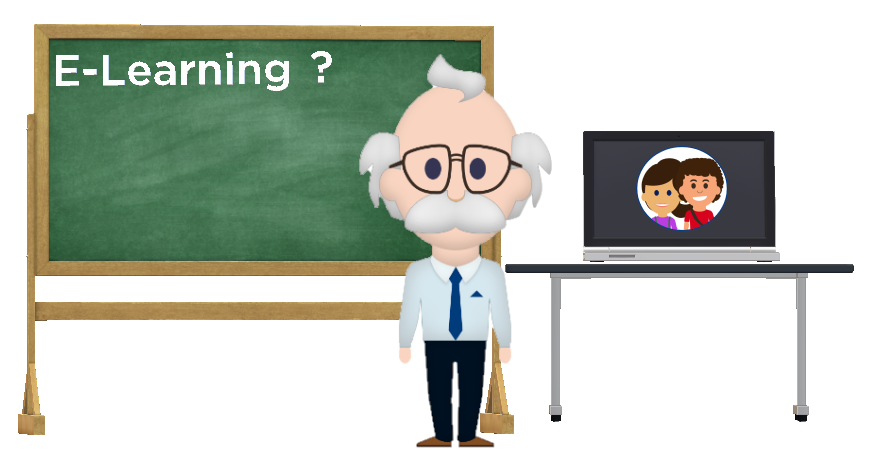
Nicht zuletzt aufgrund der Corona-Pandemie nehmen digitale Lehr-und Lernformate einen hohen Stellenwert in allgemeinen Bildungsprozessen, in Schulen und Hochschulen ein.
Dennoch existieren einige Fragezeichen und viele Herausforderungen rund um die technische und didaktische Aufbereitung entsprechender Angebote, die zum einen bildungspolitischen Strategien Rechnung tragen sollen und zum anderen personelle und infrastrukturelle Anforderungen im Blick haben müssen.
Das Thema E-Learning bzw. ein Lehren und Lernen mit Hilfe von digitalen Medien soll demnach hier differenziert vorgestellt und eingeordnet werden.
In diesem Kurs sollen Lehrende, Lernende und Interessierte das Thema E-Learning, die verschiedenen Erscheinungsformen, aktuelle Best-Practice-Modelle in der Lehre und die zugrundeliegenden Elemente kennen lernen und ein Grundverständnis (im Sinne einer didaktischen Herangehensweise) für digitale Lehrszenarien vermittelt bekommen.-
Kursziel
- Sie kennen die Bedeutungen zentraler Begriffe wie "E-Learning", "E-Teaching", "Blended Learning" und verstehen Verzahnungsmöglichkeiten von Online- und Präsenzlehre im Rahmen von verschiedenen Blended Learning-Szenarien.
- Sie kennen die Diskussionen um die
Begrifflichkeiten rund ums "E" und die Digitalisierung in der Lehre,
können sich eine Meinung bilden und diese vertreten.
- Sie können mediale Unterstützung in der Lehre auf verschiedenen Dimensionen (z.B. individuell ↔ kooperativ, synchron ↔ asynchron, selbstgesteuert ↔ geführt, interaktiv ↔ rezeptiv) einordnen.
- Sie wissen um das Spannungsverhältnis zwischen (überzogenen) Erwartungen und echtem Mehrwert von E-Learning, können außerdem den Einsatz von E-Learning an Hochschulen (bzgl. Lehrinnovation, Hochschulmarketing und Imagewirkung, Bildungspolitische Ebene) bewerten.
- Sie kennen die häufigsten Bedenken gegenüber E-Learning.
- Sie wissen um die Bedeutung digitaler Lehr- und Lernprozesse für Lehrende und Studierende.
-
Kursinformationen & Login
Gastzugang oder Login?
Prinzipiell stehen alle statischen Kursinhalte (z.B. Texte, Videos, Downloads, Links) ohne besondere Konfiguration allen Nutzenden zur Verfügung - auch den Gästen (nicht eingeloggten TH-Angehörigen oder auch Nicht-Hochschulangehörigen).
Hochschulangehörige können Ihren TH-Account nutzen, sie können sich aber - wie alle Nicht-Hochschulagehörigen auch - unter https://moodle.thga.de/login/signup.php ein (optional pseudonymisiertes) Konto anlegen.
-
Inhaltsverzeichnis
1. E-Learning – Annäherung und Differenzierung
2. Erscheinungsformen und Szenarien
3. Elemente und Eigenschaften von E-Learning
4. Digitales Lehren - Theorie & Praxis
Quiz
Literatur
Quellen
-
 Kerres (2013: 6) ordnete die Umschreibung E-Learning als eine Art „Oberbegriff für alle Varianten der Nutzung digitaler Medien zu Lehr- und Lernzwecken“ ein.
Kerres (2013: 6) ordnete die Umschreibung E-Learning als eine Art „Oberbegriff für alle Varianten der Nutzung digitaler Medien zu Lehr- und Lernzwecken“ ein.Die Begrifflichkeit E(lectronic)-Learning unterliegt keiner einheitlichen Definition und wird einem D(igital)-Learning untergeordnet bzw. durch diese Bezeichnung zum Teil ersetzt (vgl. Kumar et al., 2003: 194).
Hoppe et al. (2003: 255) grenzen noch das sogenanntes M(obile)-Learning als Teilmenge vom E-Learning ab, welches den Fokus auf ein Lernen mit mobilen Geräten und drahtloser Übertragung setzt.
Ein digitales Lehren und Lernen kann auf unterschiedlichste Art und Weise umgesetzt werden, sollte jedoch didaktischen und pädagogischen Zielsetzungen unterliegen und eine zielgruppenadäquate Inszenierung verfolgen. Ergänzende und vertiefende Informationen dazu finden Sie auch in dem Kurs Mediendidaktik!
Die unterschiedlichen Szenarien, ihre Eigenheiten und Schnittmengen digitaler Lehre werden nachfolgend erläutert sowie Empfehlungen für eine praktische Umsetzung diesbezüglich zusammengefasst.
Einige Best-Practice Beispiele sollen abschließend die vorgestellten Theorien in konkrete Lehr- und Lernszenarien überführen.
Grundsätzlich lässt sich aufgrund der langjährigen Etablierung der Begrifflichkeit E-Learning eine in vielen Institutionen und Einrichtungen gewisse Legitimation im Sinne eines Wiedererkennungswertes und damit verbundenen Vorstellungen konstatieren, differenziert betrachtet sollte man jedoch in verschiedene Lehr- und Lernsettings unterscheiden und die jeweiligen Charakteristika der zugrundeliegenden Methodik betrachten.E-Learning meint alle Einsatzvarianten digitaler Medien und Informations-/Kommunikationstechnologien zur Initiierung oder Unterstützung von Lehr- und Lernprozessen in didaktisch zielgerichteten Lehr-Lern-Arrangements.-
1.1 Das E in E-Learning nicht mehr zeitgemäß
 Einige Autoren lehnen E-Learning mittlerweile
als Bezeichnung für den Einsatz neuer Medien in Lehr- und Lernprozessen ab, da
es nicht mehr zeitgemäß erscheint, die kognitive Perspektive von Lernprozessen
vernachlässigt wird, sich unterschiedlichste Lernformate etabliert haben und u.a.
ein anderes Lernen mit dem Buchstaben E als ohne suggeriert wird (vgl. Bachmann
et al., 2009; Czerwionka, 2015).Die binäre Gegenüberstellung von E- und "Nicht-E-" Learning ist nicht zielführend: Es wird eine Konkurrenz suggeriert, die keine ist!
Einige Autoren lehnen E-Learning mittlerweile
als Bezeichnung für den Einsatz neuer Medien in Lehr- und Lernprozessen ab, da
es nicht mehr zeitgemäß erscheint, die kognitive Perspektive von Lernprozessen
vernachlässigt wird, sich unterschiedlichste Lernformate etabliert haben und u.a.
ein anderes Lernen mit dem Buchstaben E als ohne suggeriert wird (vgl. Bachmann
et al., 2009; Czerwionka, 2015).Die binäre Gegenüberstellung von E- und "Nicht-E-" Learning ist nicht zielführend: Es wird eine Konkurrenz suggeriert, die keine ist! -
1.2 Digitale Medien - "Mehrwert" für Bildung?
Ob digitale Medien und deren vielfältiger Einsatz in Lehr- und Lernszenarien einen Mehrwert für Bildungsprozesse darstellen, soll in diesem Kapitel hinterfragt werden.Krommer (2018) kritisierte den Begriff Mehrwert im Zuge des Einsatzes von Medien in Bildungsprozessen, da dieser unscharf ist und es keine klaren Kriterien für die Bestimmung von didaktischem oder pädagogischem Wert gibt. Medien dürfen nicht lediglich als Werkzeuge verstanden werden, sondern sie prägen die gesamte Struktur und Kultur des Bildungssystems hin zu einer Medienkulturdidaktik (vgl. ebd.).
Schon Manuel Castells (2001) bescheinigte Medien und Technologie in seinem Buch Aufstieg der Netzwerkgesellschaft entscheidenden Einfluß auf kommunikations- und identitätsbildende Prozesse des Einzelnen.
„Kommunikation prägt die Kultur entscheidend“ (Castells, 2001: 376).Wenn man diese Entwicklungen anerkennt und wahrnimmt, so greift der Begriff Mehrwert im Zusammenhang mit digitalen Lehr- und Lernszenarien als zu kurz. Ein grundlegender Wandel hat das Bildungssystem erfasst und es findet ein Paradigmenwechsel von der Typografie zur Digitalität (Krommer, 2018) statt.Diese Entwicklung hat auch tiefgreifenden Einfluss auf die Gesellschaft und das Miteinander.Die Auswirkung dieser Vernetzung beeinflusst ebenfalls das „[…]Verständnis dessen, was Menschsein bedeutet“ (Christakis & Fowler, 2009: 50). Das Handeln und Wirken Einzelner in einer vernetzten Welt kann in einer „Art sozialer Kettenreaktion“ (ebd.: 50) münden, unterschiedliche Menschen positiv wie negativ beeinflussen und einen selbst zum „Teil von etwas Größerem“ (ebd.: 51) werden lassen. Diese Feststellung birgt Chancen und Risiken zugleich, lässt aber folgende Schlussfolgerung zu:„Ein Bewusstsein um unsere Vernetzung mit anderen Menschen verändert notwendig unsere Vorstellung der freien Entscheidung“ (ebd.: 52). -
1.3 Pinguin-Metapher
 Die digitale Welt kann auch als völlig neues Medium verstanden werden, wie die Pinguin Metapher von Muus-Meerholz (2018) aufzeigt.
Die digitale Welt kann auch als völlig neues Medium verstanden werden, wie die Pinguin Metapher von Muus-Meerholz (2018) aufzeigt.Pinguine bewegen sich in zwei verschiedenen Medien(welten), im Wasser und auf dem Land. Sie bewegen sich in beiden Medienwelten jedoch völlig unterschiedlich, da im jeweiligen Medium gänzlich andere Bedingungen herrschen. Es ist daher nur schwer möglich, Vergleiche der Medien im Sinne eines "Mehrwertes" anzustellen!
Der Mensch findet sich, ebenso wie der Pinguin, mit einem komplett neuen Medium konfrontiert bzw. er befindet sich eingentlich schon mittendrin! Dieser Übergang von einem in das andere Medium verursacht evtl. Probleme und Schwierigkeiten, da der alte Maßstab nicht 1:1 in die neue Medienwelt übersetzt werden kann. Erkunden und Erproben hilft Verständnis und Fortbewegen in dem neuen Medium zu fördern, Vergleiche zur alten Welt helfen dort nur bedingt!
Die Pinguin Metapher hilft Verständnis für eine Transformation von einer analogen zur digitalen Welt aufzubauen und die Schwierigkeit einer 1:1 Übertragung herauszustellen!Für Lehrende ist es damit z.B. nicht getan, Ihre Vorlesung von 90 Minuten abzufilmen und ins Netz zu stellen. Lehren und Lernen folgt hier anderen didaktischen Gesetzmäßigkeiten und erfordert eine tiefergehende Auseinandersetzung mit den Bedingungen, Möglichkeiten und Methoden, die die digitale Welt beinhaltet.
-
-
In welcher Art und Weise werden digitale Lehr- und Lernszenarien umgesetzt und welche Unterscheidungen sind vorzunehmen?
-
2.1 Virtualisierungsgrad von Lehre
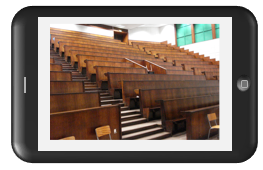
E-Learning-Angebote bzw. digitale Lehr- und Lernszenarien lassen sich anhand eines Virtualisierungsgrades differenzieren und analysieren.
Die Frage nach dem Virtualisierungsgrad von Lehre lässt sich daher mit den verschiedenen Einsatzarten und dem Anteil von digitalen Medien am Unterrichtsgeschehen beantworten. Ein Virtualisierungsgrad von 0 bedeutet keinen Einsatz von digitalen Medien und eine rein klassische Vermittlung.
Unabhängig von der didaktischen Umsetzung, lassen sich diesbezüglich drei verschiedene Konzepte einer Virtualisierung von Lehre unterscheiden:
· Anreicherungskonzept (= Virtualisierungsgrad 1-3)
· Integrationskonzept (= Virtualisierungsgrad 4)
· Virtualisierungskonzept (= Virtualisierungsgrad 5)
Beim Anreicherungskonzept nehmen digitale Medien eine ergänzende Funktion ein, da sie als Hilfsmittel z.B. im Sinne einer Verteilung von Materialien und/oder zur Kommunikation dienen. Klassischen Formen der Lehre werden sozusagen beibehalten, digitale Medien besitzen aber einen additiven Charakter und werden eingesetzt.Virtualisierungsgrad 1
Virtualisierungsgrad 2
Virtualisierungsgrad 3
Powerpoint Folien / PDFs
Lernplattform-Einsatz
Multimediale Anwendungen
Office-Dokumente
Organisation Veranstaltung
Interaktivität (z.B. Tests)
Cloudspeicher-Nutzung
Aufgaben online / Termine
Codierungsvielfalt (Video)
Austauschmöglichkeiten
versch. Sinnesmodalitäten
Tools werden ausgereizt
Beim Integrationskonzept bilden Präsenz- und digitale Lehre ein gleichwertiges und alternierendes Konstrukt, man spricht hierbei auch von Blended-Learning oder hybriden Lehrformen. Zumeist eignen sich die Lernenden die bereitgestellten Lerninhalte z.B. über eine Lernplattform im Selbststudium an, nutzen die Präsenzphasen dann zur intensiven Diskussion, Vertiefung einzelner Themen und zum kollaborativen Arbeiten in (Klein-)Gruppen. Der Lehrende nimmt in diesen Prozessen eher die Rolle eines Tutors und Moderators ein. Dieses didaktische Konzept wird auch als „Inverted“ (umgekehrt) oder „Flipped“ - Classroom bezeichnet und kombiniert die Vorteile der Präsenz- mit denen der Onlinelehre.Virtualisierungsgrad 4
Wissensvermittlung online
Selbstbestimmtes, flexibles Lernen
Präsenzphasen zur Vertiefung, Diskussion
Vielfältige Methoden u. Interaktionen
Das Virtualisierungskonzept stellt die höchste Stufe (5) bei den Virtualisierungsgraden dar. Die Lehre findet hierbei rein im digitalen Raum statt und Präsenzphasen sind nicht vorgesehen. Man unterscheidet dieses Konzept dann noch in eine synchrone (=live) und/oder asynchrone (Aufzeichnung) Vermittlung, die auch kombiniert umgesetzt werden können.Virtualisierungsgrad 5
Alleinige, digitale Vermittlung ; Onlinekurse
Foren, Chats, Email à Digitale Kommunikation
Hoher Betreuungsaufwand
Lehrende gefordert als Tutor, Moderator
Der Trend und die aktuelle Entwicklung favorisieren einen Virtualisierungsgrad 4, da hier die Vorteile der Präsenz- und Onlinelehre kombiniert werden und es in vielerlei Hinsicht den Anforderungen der heutigen Arbeitswelt 4.0 nahe kommt! -
2.2 E-Teaching / Distanzlehre

Das Electronic-Teaching ist ebenso wie das E-Learning nicht klar definiert und wird oftmals mit Begriffen wie Teleteaching, Distance Teaching oder E-Moderating etc. synonym verwendet.
Gemein haben diese Bezeichnungen die Abgrenzung zur klassischen Präsenzlehre, da ein E-Teaching eine synchrone (=live; Bsp.: Virtuelles Klassenzimmer) Vermittlung oder eine asynchrone Lehre (Bereitstellung von Content über z.B. eine Lernplattform; z.B. Aufzeichnung einer Vorlesung) meint.
Im Unterschied zum E-Learning stellt das E-Teaching die Perspektive der Lehrenden in den Vordergrund, ihre didaktische Methodik und ihr ausgewähltes Lehr- und Lernsetting.
Fragestellungen und Herausforderungen einer synchronen/asynchronen Distanzlehre finden Sie unter 2.4.3 tiefergehend erläutert... -
2.3 Blended Learning / asynchrone Hybridlehre
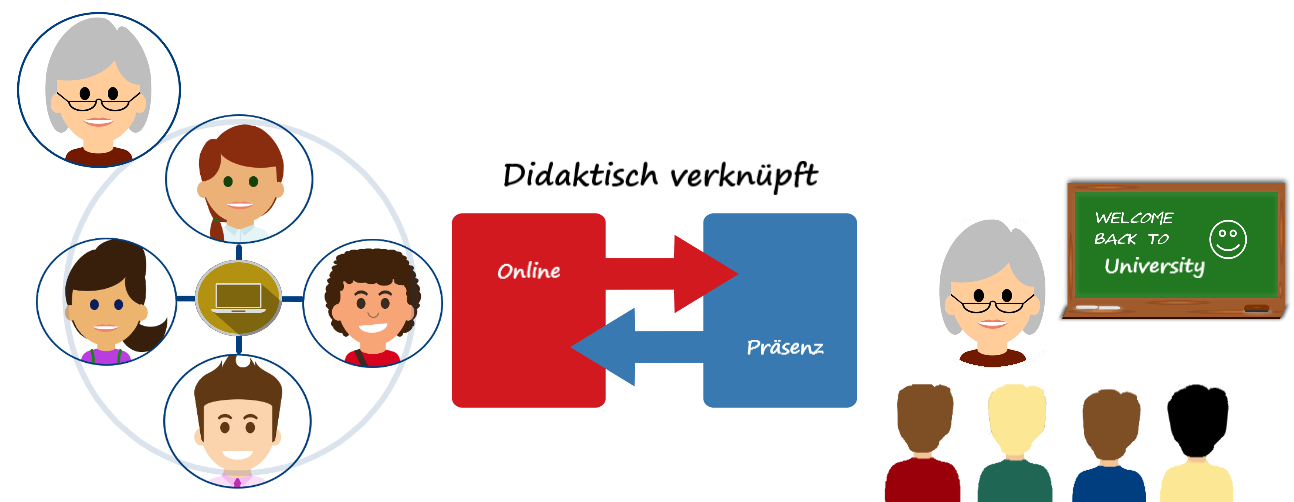 Eine Mischform der Präsenzlehre und einer Lehre im digitalen Raum bezeichnet man als Blended (vom englischen to blend = mischen) - Learning oder auch z.T. unscharf als hybride Lehre (wobei hier noch zwischen synchroner / asynchroner Vermittlung differenziert wird). Während bei einer hybriden Veranstaltung nicht alle Lernenden in einem Raum zusammen sind (Präsenz- und zeitgleich Onlinepublikum), sind in einem Blended Learning Szenario alle Lernenden (je nach Phase) zusammen online oder eben gemeinsam vor Ort vereint.
Eine Mischform der Präsenzlehre und einer Lehre im digitalen Raum bezeichnet man als Blended (vom englischen to blend = mischen) - Learning oder auch z.T. unscharf als hybride Lehre (wobei hier noch zwischen synchroner / asynchroner Vermittlung differenziert wird). Während bei einer hybriden Veranstaltung nicht alle Lernenden in einem Raum zusammen sind (Präsenz- und zeitgleich Onlinepublikum), sind in einem Blended Learning Szenario alle Lernenden (je nach Phase) zusammen online oder eben gemeinsam vor Ort vereint.Hierbei werden die Vorteile einer Präsenzlehre mit denen einer reinen digitalen Vermittlung kombiniert. Ein individuelles, zeit- und ortsunabhängiges Lernen kann z.B. über einen Kurs auf einer Lernplattform ermöglicht werden, ohne den sozialen Kontakt, den Austausch und ein Miteinander in einer Präsenzphase zu vernachlässigen. Die Präsenzphase kann hybrid, im Sinner eine gleichzeitigen Präsenz- und Onlineveranstaltung, oder im Wechsel mit Onlinephasen (wie bei Blended-Learning Konzepten vorgesehen) durchgeführt werden.
Es gilt also eine gute Balance und didaktische Verknüpfung zwischen Präsenz- und Onlinelehre herzustellen. Dies erfordert von der Organisation und Koordination häufig einen Mehraufwand bei Lehrenden und Lernenden, spiegelt jedoch Trends und Anforderungen der heutigen Arbeitswelt (kollaboratives Arbeiten) wieder und erfährt dadurch eine besondere Relevanz (vgl. Quade, 2017).
Aktuelle Studien deuten darauf hin, dass gut konzipierte Blended-Learning-Szenarien zu mehr Motivation, erhöhter Selbstwirksamkeit sowie einem besseren Lernerfolg führen können (Rafiola et al., 2020). Verschiedene Modelle zur Umsetzung entsprechender Szenarien finden sich u.a. bei Christensen et al. (2013). -
2.4 Szenarien - Beispiele & Vertiefungen
Statt eine Gegenüberstellung von E-Learning und analoger Lehre vorzunehmen, lassen sich über verschiedene Szenarien auch Schnittmengen feststellen und Anknüpfungspunkte für z.B. hybride Lehr- und Lernarrangements finden!Die nachfolgende Grafik differenziert verschiedene Szenarien von Lehre anhand der Schnittmengen:- selbstgesteuert, kooperativ, asynchron, interaktiv -> Arbeit in einem Wiki, Forendiskussion
- geführt, kooperativ, synchron, interaktiv -> Gruppenarbeit an einer Aufgabenstellung, Breakout-Room einer Videkonferenz
- selbstgesteuert, individuell, interaktiv -> Selbstüberprüfung in einem Online-Test, H5P, Online-Simulation eines Laborversuchs
- individuell, geführt, passiv -> Rezeption eines Lehrvideos oder einer Vorlesungsaufzeichnung
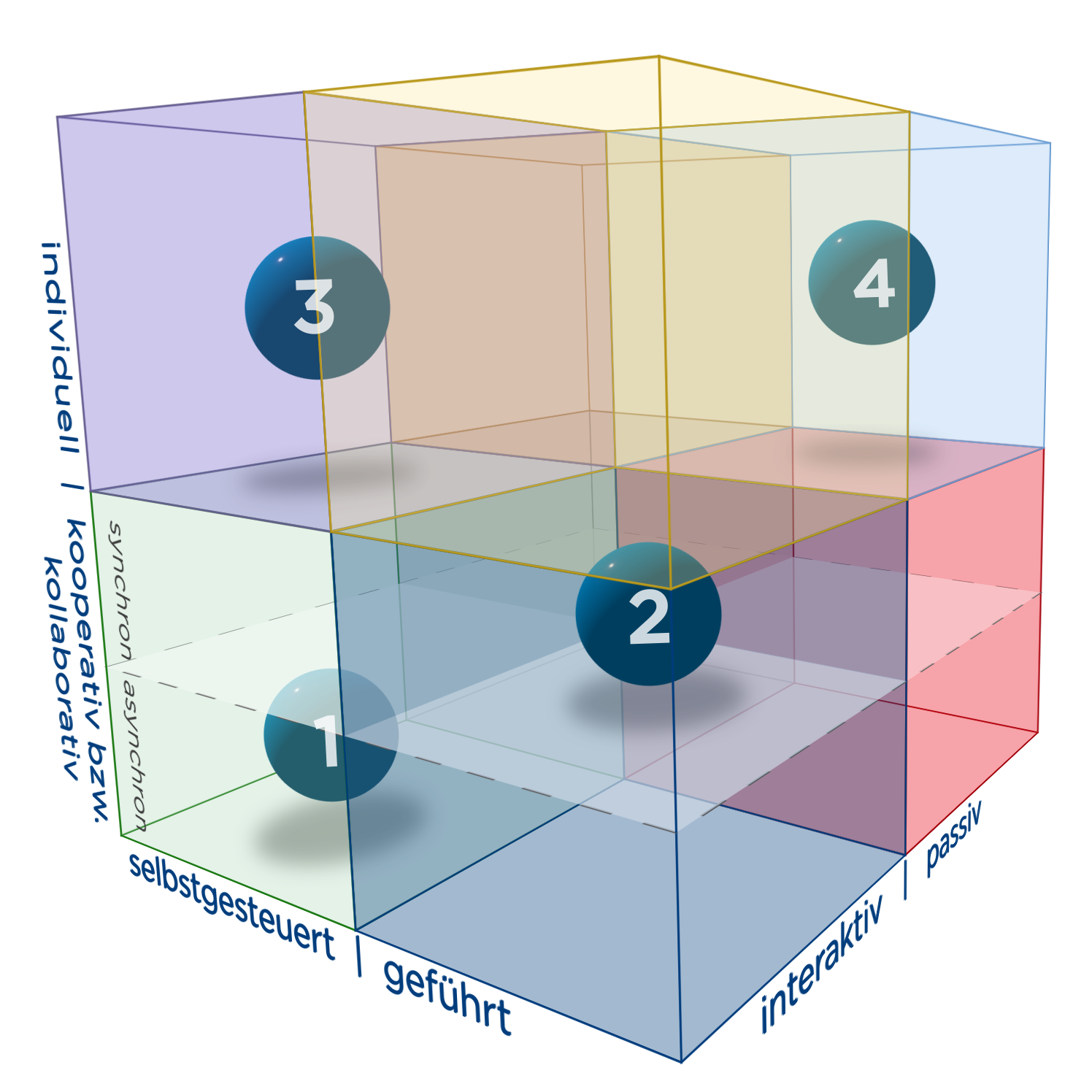 Nachfolgend sollen einige dieser Szenarien der Praxis tiefergehend beleuchtet werden und Ihnen über weitergehende Links & Informationen Hilfestellung für eine Umsetzung sein!
Nachfolgend sollen einige dieser Szenarien der Praxis tiefergehend beleuchtet werden und Ihnen über weitergehende Links & Informationen Hilfestellung für eine Umsetzung sein! -
2.4.1 Inverted / Flipped Classroom
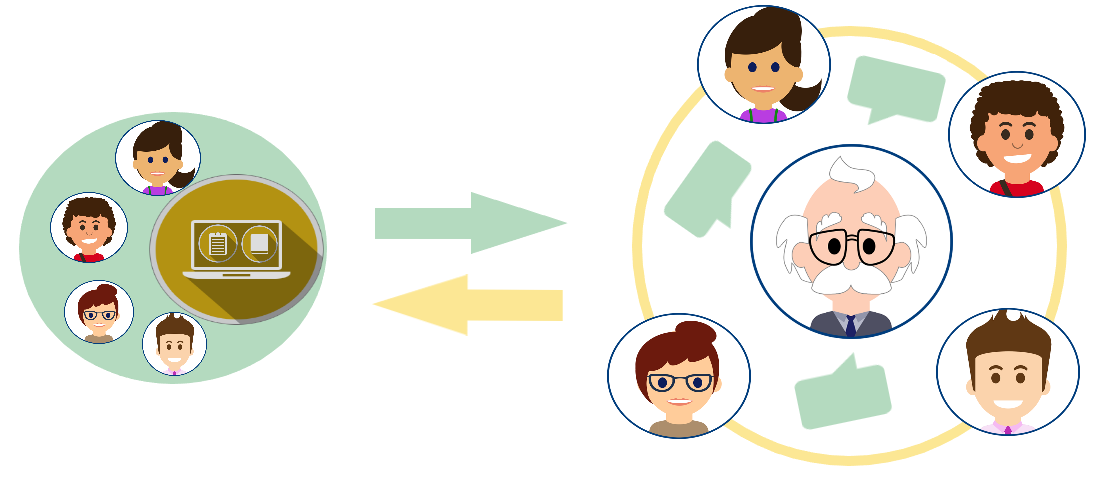
Ein beliebtes Szenrario, welches als Teil von Blended-Learning verstanden werden kann, spiegelt sich im umgekehrten (= inverted) Klassenzimmer wieder.
Lernende sollen sich (im Sinne einer Individualisierung von Lernen) grundlegende Inhalte in einer Art Selbststudium über z.B. eine Lehr- und Lernplattform aneignen und die Präsenzphasen dann dafür nutzen, vertiefende Themen zu diskutieren und kollaboratives bzw. koopeatives Arbeiten an z.B. fachspezifischen Problemen und Fragestellungen zu initiieren.
Die Lehrkraft dient bei diesen Lernprozessen als Moderator und Begleiter, der die grundlegenden Inhalte vorab zur Verfügung stellt und ggfls. erweitert und anpasst. Mertens et al. (2019: 343) konstatieren in diesem Zusammenhang: „Lehrende sind angehalten, modularisierte Angebote zu erstellen, die ein Überspringen oder Wiederholen von Lernstoff ermöglichen.“
Der Vorteil dieses Konzeptes liegt in der zeit- und ortsunabhängigen Bereitstellung von Lernstoff, welches eine Flexibilisierung des Lernens aufgrund der technischen und digitalen Entwicklung in der Gesellschaft etabliert hat. Die Selbststeuerung des Lernens erfordert vom Lernenden wiederrum mehr Selbstdisziplin und Eigenverantwortung, von Seiten der Lehrenden eine aufwendigere, didaktische Inszenierung unter Berücksichtigung der technischen Voraussetzungen und der eigenen digitalen Kompetenzen. -
2.4.2 Hybride Lehre (synchrone Veranstaltung)
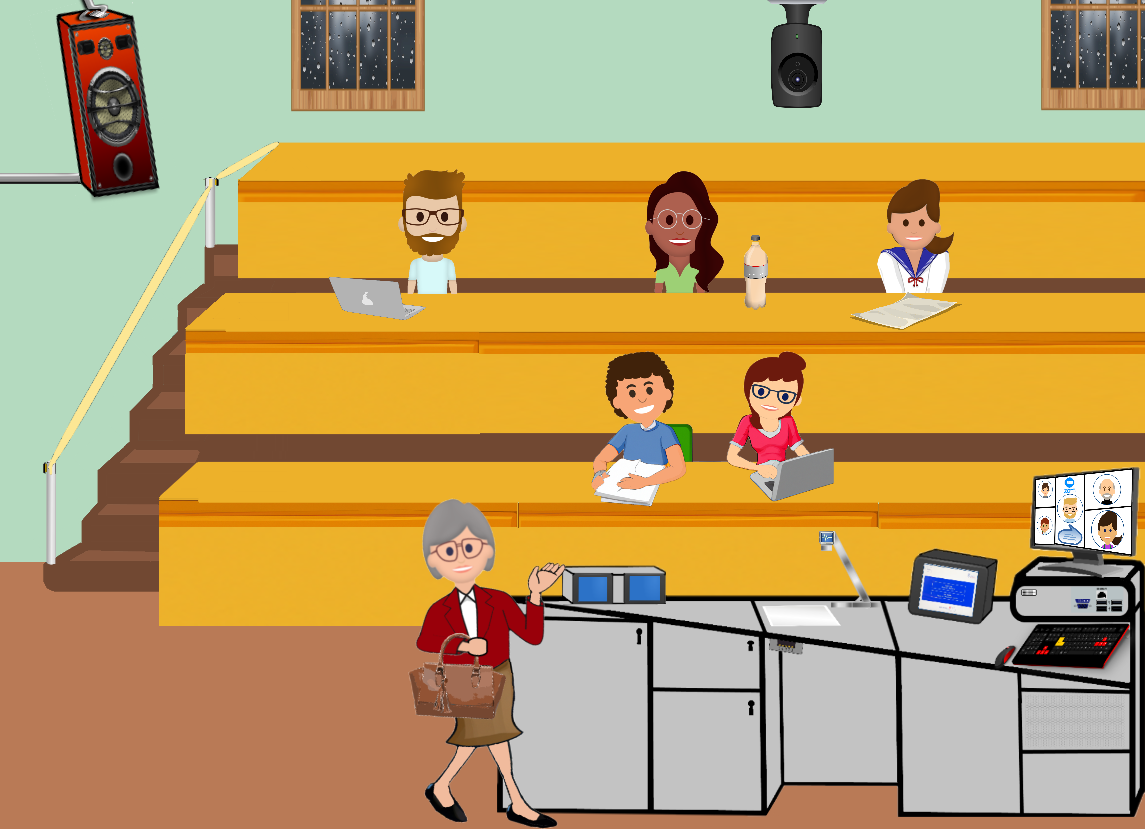
Was meint hybride Lehre?
Eine hybride Lehrveranstaltung meint hier ein synchrones ("live") Lehr- und Lernszenario, bei dem ein Teil der Studierenden online, der andere Teil gleichzeitig in Präsenz teilnimmt!Diese Veranstaltungsart bringt einige Herausforderungen für Lehrende und auch Studierende mit sich, die es nachfolgend zu erörtern gilt.Darüber hinaus werden wir einige Erfahrungswerte und Hinweise aus der Praxis zusammenfassen, die Ihnen für die Umsetzung entsprechender Szenarien Hilfe leisten können.Warum überhaupt hybride Lehre?
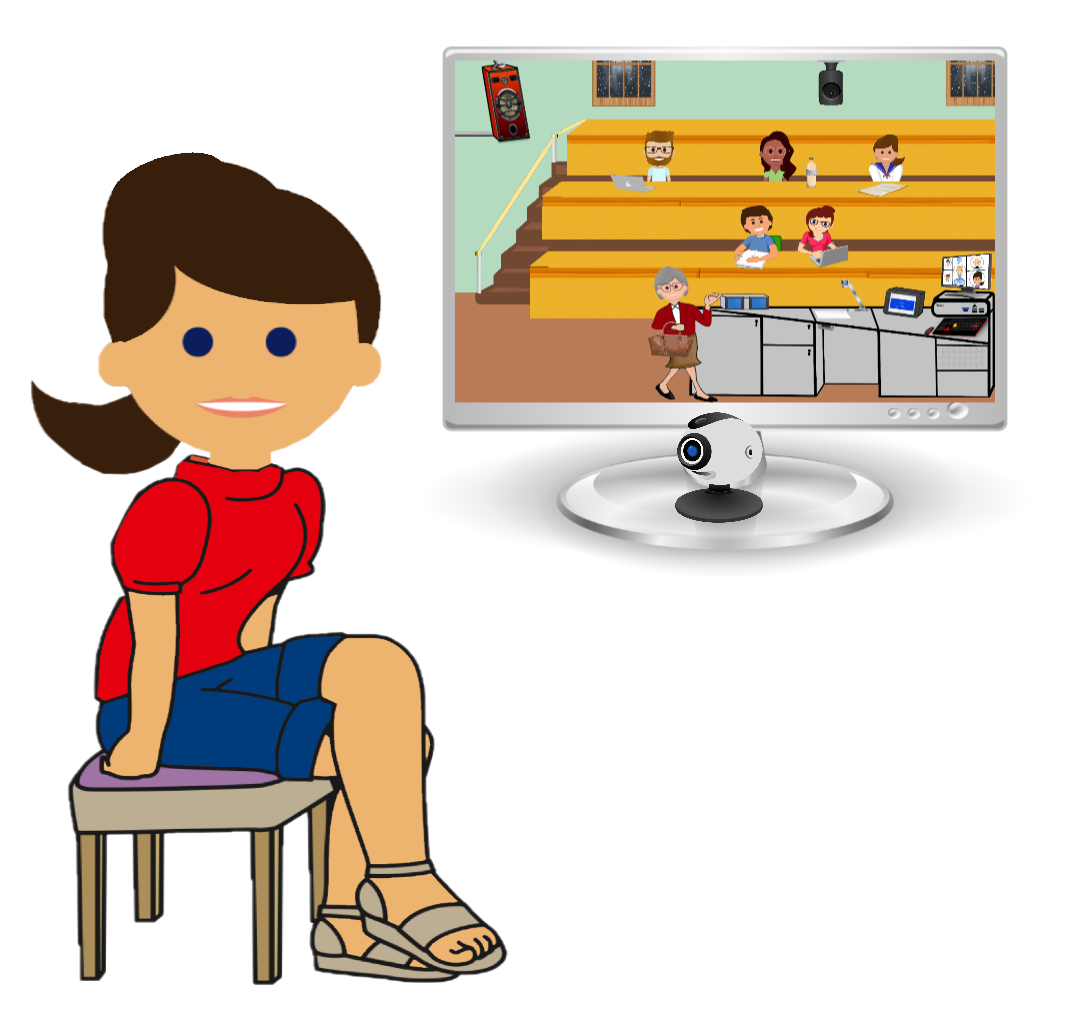 Der Vorteil dieses Lehr- und Lernszenarios besteht in der flexiblen
Teilnahmemöglichkeit von Studierenden. Z.B. müssen Teilzeit- und/oder
berufsbegleitende Studierende nicht zwingend vor Ort sein, um am
Unterricht teilzunehmen! Zudem könnten auch internationale oder
inklusive Studierende an solchen Angeboten partizipieren, die aufgrund
der Distanz bzw. besonderer Lebensumstände nicht persönlich vor Ort
erscheinen würden/könnten.Bei gutem methodisch-didaktischen Design kann auch ein kollaboratives Arbeiten in Teams gefördert und geschult werden, welches in der heutigen Arbeitswelt einen hohen Stellenwert einnimmt und Studierende dahingehend vorbereiten kann!Darüber hinaus kann der Einsatz und der Umgang mit digitalen Tools (z.B. Whitboards, ARS-Systeme) in Live-Settings erprobt werden und ein anderer Zugang zu Informationen/Lerninhalten und deren Dokumentation geschaffen werden.Ziel: "[...]die Erweiterung der Handlungsoptionen und damit das Ermöglichen einer Vielfalt der Aktivitäten bei denen auf unterschiedliche Weise gelernt wird." (Kohls & Dubbert, 2023: 12)
Der Vorteil dieses Lehr- und Lernszenarios besteht in der flexiblen
Teilnahmemöglichkeit von Studierenden. Z.B. müssen Teilzeit- und/oder
berufsbegleitende Studierende nicht zwingend vor Ort sein, um am
Unterricht teilzunehmen! Zudem könnten auch internationale oder
inklusive Studierende an solchen Angeboten partizipieren, die aufgrund
der Distanz bzw. besonderer Lebensumstände nicht persönlich vor Ort
erscheinen würden/könnten.Bei gutem methodisch-didaktischen Design kann auch ein kollaboratives Arbeiten in Teams gefördert und geschult werden, welches in der heutigen Arbeitswelt einen hohen Stellenwert einnimmt und Studierende dahingehend vorbereiten kann!Darüber hinaus kann der Einsatz und der Umgang mit digitalen Tools (z.B. Whitboards, ARS-Systeme) in Live-Settings erprobt werden und ein anderer Zugang zu Informationen/Lerninhalten und deren Dokumentation geschaffen werden.Ziel: "[...]die Erweiterung der Handlungsoptionen und damit das Ermöglichen einer Vielfalt der Aktivitäten bei denen auf unterschiedliche Weise gelernt wird." (Kohls & Dubbert, 2023: 12)Herausforderungen
1. Technische Ausstattung:Eine hybride Lehrveranstaltung erfordert eine ausreichende, moderne technische Ausstattung, um gerade die Online-Komponenten zu unterstützen. Dies kann beispielsweise eine stabile Internetverbindung, geeignete Hardware und Software sowie die Kenntnis der verwendeten Tools erfordern (in der THGA z.B. in Raum 218 vorhanden). Darüber hinaus sollten sich Lehrende mit der Bedienung und Handhabe der Technik vorab vertraut machen!
2. Didaktisches Konzept & Vermittlung:Um sicherzustellen, dass die hybride Lehrveranstaltung für alle Studierenden erfolgreich verläuft, muss ein geeignetes didaktisches Konzept entwickelt werden. Hierbei müssen Aspekte wie die Art und Weise, wie Inhalte präsentiert werden, die Aufgabenstellung und die Interaktion zwischen den Studierenden berücksichtigt werden (mehr dazu auch in diesem Kurs).
3. Zeitmanagement:Bei hybriden Lehrveranstaltungen, bei denen Präsenz- und Online-Aktivitäten kombiniert werden, ist ein effektives Zeitmanagement unerlässlich. Es ist wichtig sicherzustellen, dass die Online-Aktivitäten so geplant werden, dass sie mit den Präsenzinhalten und dem geplanten Ablauf koordiniert werden.
4. Sozialer Austausch:Eine der größten Herausforderungen bei hybriden Lehrveranstaltungen ist es, den sozialen Austausch zwischen den Studierenden aufrechtzuerhalten. Dies ist besonders wichtig, da diese Art von Veranstaltungen oft ein höheres Maß an Selbstorganisation erfordern, was dazu führen kann, dass einige Studierende sich isoliert fühlen und/oder eine gut strukturierte Gruppenarbeit verhindert wird.Fragestellungen als Konsequenz
- Welche Technologie ist vorhanden und wird benötigt, um die Online-Komponente der Lehrveranstaltung einwandfrei durchzuführen?- Wie kann das didaktische Konzept so gestaltet werden, dass es sowohl online als auch offline bzw. vor Ort funktioniert?- Wie können Lehrende sicherstellen, dass die Studierenden, die online teilnehmen, ausreichend Möglichkeiten für Fragen und Anmerkungen haben (Rückkanal/Gleichbehandlung)?- Wie kann der soziale Austausch zwischen den Studierenden unterstützt werden, um sicherzustellen, dass sie sich nicht isoliert fühlen und gemeinsame Arbeit / Kommunikation funktioniert?- Wie kann das Zeitmanagement optimiert werden, um sicherzustellen, dass sowohl online als auch offline Aktivitäten koordiniert werden können?- Wie gestalten Sie Kooperation / Kollaboration in Gruppen in diesem Setting?Gestaltungshinweise & Erfahrungswerte
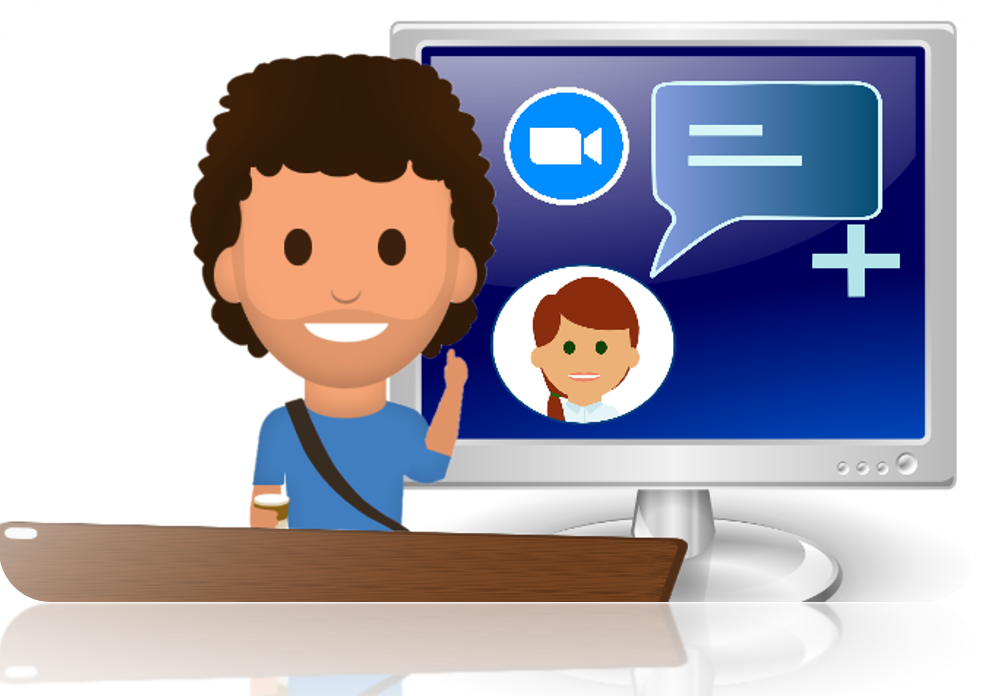
Co-Moderation:
Studierende als Co-Moderator/In erleichtern Ihnen als Lehrperson die Übersicht über Wortmeldungen und Fragen Ihres Distanzpublikums.
Über den Chat, ARS-Tools oder z.B. Handzeichen können entsprechende Rückmeldungen des Distanzpublikums erfasst, gehört und/oder geordnet werden.
Diese Entlastung setzt natürlich eine aufmerksame und zuverlässige Person voraus, die von Ihnen instruiert wird und als Ansprechpartner/in dient!
Die Rolle sollte im Wechsel von Studierenden vergeben werden, sofern keine wissenschaftliche Hilfskraft oder Dritte hierfür verfügbar sein sollten.
Die Beteiligung und auch Aktivierung des Distanzpublikums entspricht dem Grundsatz der Gleichbehandlung und sollte nicht zuletzt deshalb geplant und mitgedacht werden!
Gerade wenn es um den Austausch, das Miteinander und die gemeinsame Er- und Bearbeitung von Lehr- und Lerninhalten in hybriden Szenarien geht,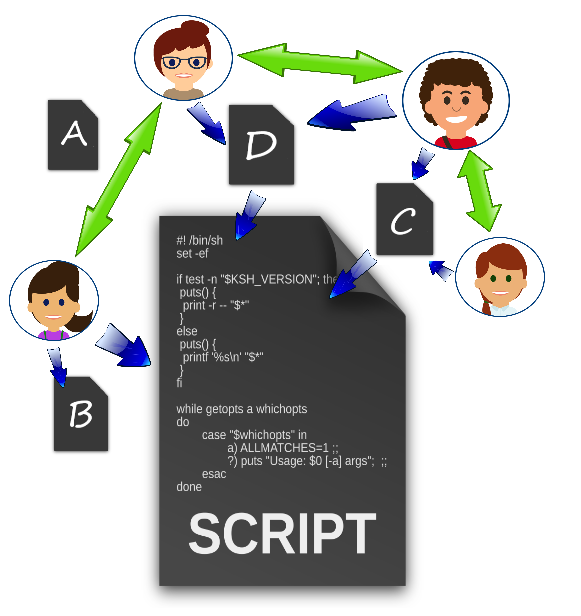 Kollaborative Aufgaben & Toolskönnen Sie kollaborative Werkzeuge nutzen, die den Fokus auf Teamarbeit, Dokumentation und letztlich ein gemeinsames Ergebnis setzen.Kollaboration adressiert (im Unterschied zu kooperativen Lernarrangements) die gemeinsame Auseinandersetzung mit Lerninhalten, den Diskurs als notwendige Bedingung und die daraus resultierende Fertigstellung eines Ergebnisses im Gesamtprozess. Tiefergehende Erläuterungen, Unterscheidungen und entsprechende Aufgabenformate finden Sie in diesem Kurs [16.03.2023].Kollaboratives Arbeiten wird mittlerweile als "Future Skill" (vgl. Hieronimus et al., 2022) im Rahmen von digitalen Schlüsselkompetenzen eingeordnet und erfährt entsprechende Relevanz in zahlreichen Branchen, Universitäten und auch im Sinne einer Teilhabe [17.03.2023] in unserer Gesellschaft!
Kollaborative Aufgaben & Toolskönnen Sie kollaborative Werkzeuge nutzen, die den Fokus auf Teamarbeit, Dokumentation und letztlich ein gemeinsames Ergebnis setzen.Kollaboration adressiert (im Unterschied zu kooperativen Lernarrangements) die gemeinsame Auseinandersetzung mit Lerninhalten, den Diskurs als notwendige Bedingung und die daraus resultierende Fertigstellung eines Ergebnisses im Gesamtprozess. Tiefergehende Erläuterungen, Unterscheidungen und entsprechende Aufgabenformate finden Sie in diesem Kurs [16.03.2023].Kollaboratives Arbeiten wird mittlerweile als "Future Skill" (vgl. Hieronimus et al., 2022) im Rahmen von digitalen Schlüsselkompetenzen eingeordnet und erfährt entsprechende Relevanz in zahlreichen Branchen, Universitäten und auch im Sinne einer Teilhabe [17.03.2023] in unserer Gesellschaft! Tools und Dienste:
Tools und Dienste:Kollaborative Texterstellung: Etherpad der THGA [26.07.2023]
Digitale Pinnwand (z.B. Collaboard, Padlet, Taskcards , pinnet)
Digitales Whiteboard (u.a. Miro, Mural, Zoom Whiteboards, Conceptboard)
Moodle-Tools zur Kollaboration (z.B. Moodle-Wiki, H5P-Inhalte )
Wichtig: Nicht alle Werkzeuge / Dienste entsprechen der DSGVO, insofern prüfen Sie vor einer Nutzung die Datenverarbeitung und informieren Sie sich diesbezüglich über aktuelle Vorgaben/Richtlinien!Gruppenarbeiten in hybriden Lehrszenarien
Wenn Sie bestimmte Aufgaben in hybriden Veranstaltungen durch ein Gruppe er- und bearbeiten lassen wollen, so stellt sich die Frage nach einer geeigneten Form und Organisation von Gruppenarbeit im physischen und virtuellen Raum.Grundsätzlich hängt die Beantwortung dieser Frage erstmal von der allgemeinen Teilnehmendenzahl, den räumlichen und technischen Gegebenheiten, den Teilnehmenden in Präsenz und der Größe Ihres Distanzpublikums ab!Nachfolgend sollen verschiedene Szenarien von Gruppenarbeit beleuchtet und Tipps zur Umsetzung zusammengefasst werden:Einige weiterführende Informationen und Gestaltungshinweise finden Sie unter diesem Link der Universität Köln [17.03.2023] -
Kleingruppen getrennt (Präsenz / Distanz)
 Kleingruppen können dazu genutzt werden, um gemeinsam an einem Thema zu
arbeiten.
Kleingruppen können dazu genutzt werden, um gemeinsam an einem Thema zu
arbeiten. Eine Thematik kann in Themenblöcke unterteilt und aufgeteilt werden und jede Gruppe arbeitet entsprechend zu einem Teilaspekt des Themas.
Hierzu können Leitfragen zur Bearbeitung vorab vorbereitet werden. Am Ende der Gruppenphasen stellt dann jede Gruppe ihr Ergebnis im Plenum vor!Für Kleingruppen von bis zu ca. 20 Lernenden, die Sie für eine Gruppenarbeit in virtuelle Gruppen und Präsenz-Gruppen getrennt unterteilen wollen, ergeben sich folgende Organisationsmöglichkeiten:
Beispiel: 10 Teilnehmende (TN) vor Ort und 8 TN virtuell:
Vor Ort bilden sich 3 Präsenz-Gruppen à 3-4 Personen und online dann 2 Gruppen à 4 Personen (in Breakoutrooms).
Methodik Beispiel: 10 Punkte / A-Z-Liste: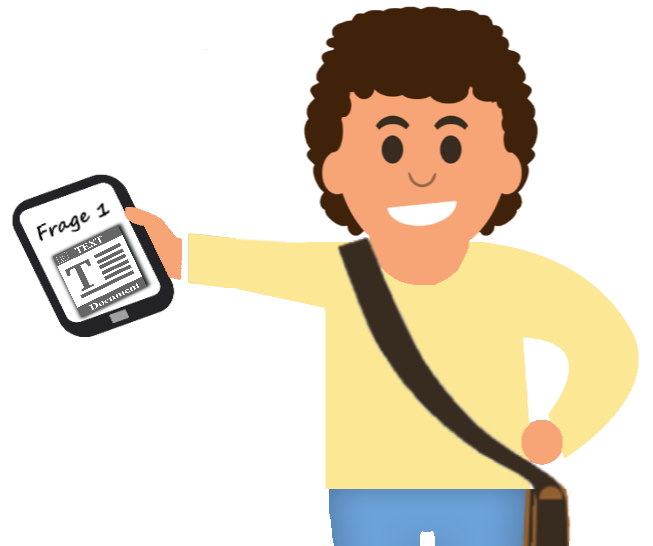 Jede Gruppe bekommt ein Thema und
erarbeitet 10 wichtige Fragen oder Punkte (von A-Z) zum Thema. Hier können z.B. Online-Whiteboards (wie in Abschnitt 2.4.2 beschrieben) zum Einsatz kommen. Beispielsweise kann für alle Gruppen ein Board mit Bereichen pro Gruppe angelegt werden.Nun erstellen die Teilnehmenden ihre Listen, die Kommunikation erfolgt weiterhin via Breakout-Raum oder via Text-Chat auf dem Online-Whiteboard. Die Ergebnisse können am Ende der Gruppenarbeit präsentiert und diskutiert werden.Weitere Methodiken und didaktische Differenzierungen der Vermittlung finden Sie in diesem Kurs [17.03.2023]
Jede Gruppe bekommt ein Thema und
erarbeitet 10 wichtige Fragen oder Punkte (von A-Z) zum Thema. Hier können z.B. Online-Whiteboards (wie in Abschnitt 2.4.2 beschrieben) zum Einsatz kommen. Beispielsweise kann für alle Gruppen ein Board mit Bereichen pro Gruppe angelegt werden.Nun erstellen die Teilnehmenden ihre Listen, die Kommunikation erfolgt weiterhin via Breakout-Raum oder via Text-Chat auf dem Online-Whiteboard. Die Ergebnisse können am Ende der Gruppenarbeit präsentiert und diskutiert werden.Weitere Methodiken und didaktische Differenzierungen der Vermittlung finden Sie in diesem Kurs [17.03.2023] -
Kleingruppen gemischt (Präsenz + Distanz)
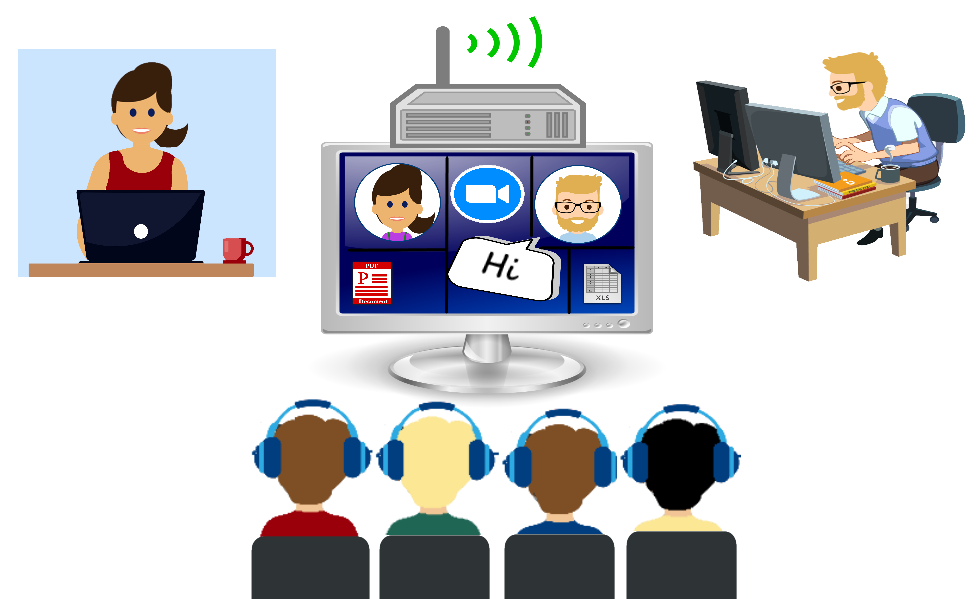
Wenn Sie für Gruppenaufgaben bzw. Gruppenarbeiten in Ihrer synchronen, hybriden Veranstaltung Präsenzteilnehmende mit Distanzteilnehmenden mischen wollen, so gilt es gewisse Vorüberlegungen in der Konzeption zu bedenken.
Grundsätzlich erhöht dieser Ansatz die Herausforderung und Komplexität des didaktischen Settings. Die Bedingungen hierzu werden nachfolgend erläutert!
Bedingung/Herausforderung:Präsenzteilnehmende brauchen in diesem Szenario für die Kommunikation mit den Distanzstudierenden Zugang zu dem verwendeten Videokonferenzsystem (z.B. Zoom) und den Breakoutrooms.Hierfür könnten Laptos und z.B. idealerweise Headsets vor Ort (räumliche Eignung und technische Verfügbarkeit?) genutzt werden, unter Umständen aber auch private Smartphones oder entsprechende mobile Endgeräte mit Zugang zum Dienst (hier: Zoom) Verwendung finden.Wichtig: Wie stellen Sie sicher, dass jede/r Teilnehmende Zugang hat bzw. auch im Sinne der Gleichbehandlung an solch einem Lernsetting partizipieren kann?Gruppeneinteilung über Breakoutrooms bei Zoom:
In Ihrem Zoom-Konto können Sie die Funktion von Breakout-Räumen aktivieren und anschließend verwalten und entsprechende Räume erstellen [17.03.2023].
Es kann hilfreich sein, Teilnehmende (sofern bekannt) im voraus schon Breakout-Räumen zuzuweisen. Die Vorgehensweise hierfür finden Sie für Zoom unter diesem Link [17.03.2023].
Wenn Sie Teilnehmenden selbst gestatten wollen, sich den Breakoutroom aus einer Liste von Räumen auszusuchen (z.B. zu einem bestimmten Thema), so finden Sie unter diesem Link der Zoom-Hilfe eine Anleitung!
Grundsätzlich empfiehlt es sich tendenziell eher Präsenz- und Distanzstudierende in Gruppenarbeiten zu trennen (gerade bei größeren Gruppen), da die geschilderten Bedingungen oftmals nicht ideal sind und der Mehrwert dieses Szenarios überschaubar bleibt! -
Große Gruppen
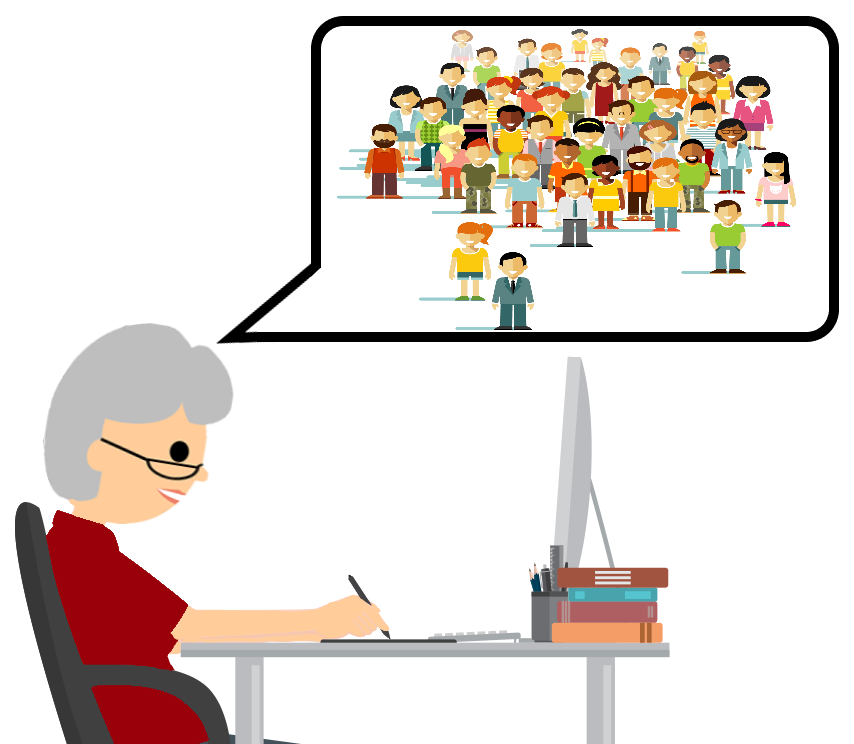 Wenn Sie eine synchrone, hybride Veranstaltung mit einer großen Gruppe umsetzen möchten, so empfiehlt es sich Präsenz- und Distanzpublikum bei möglichen Gruppenarbeiten zu trennen.
Wenn Sie eine synchrone, hybride Veranstaltung mit einer großen Gruppe umsetzen möchten, so empfiehlt es sich Präsenz- und Distanzpublikum bei möglichen Gruppenarbeiten zu trennen.Es können hierbei z.B. digitale Whiteboards oder digitale Pinnwände genutzt werden, um Lösungswege und Ergebnisse zu dokumentieren, zu archivieren sowie beiden Gruppen gleichermaßen zugänglich zu machen.
Interaktivität und Partizipation lässt sich in diesem Szenario sehr gut mit Audience Response Systemen (ARS) herstellen, bei denen Sie Fragen, Abstimmungen und/oder Thesen vorbereiten und im Unterricht dann direkt einsetzen und diskutieren können.
Einige Praxistipps und Empfehlungen zur Gestaltung von entsprechenden hybriden Szenarien finden Sie unter anderem hier und hier [17.03.2023] -
Literatur & Links zu hybriden Lehr-/Lernszenarien

Eine große Sammlung von Links, Informationen und Praxiserfahrungen finden Sie hier:
https://cloud.ovgu.de/s/pCEtmdfq2yL8oqR [17.03.203]
Darüber hinaus interessante Links: [17.03.2023]
https://www.sell.hhu.de/fileadmin/E-Learning/Downloads/Didaktischer_Leitfaden_Hybridlehre.pdf
-
2.4.3 Distanzlehre (synchron / asynchron)
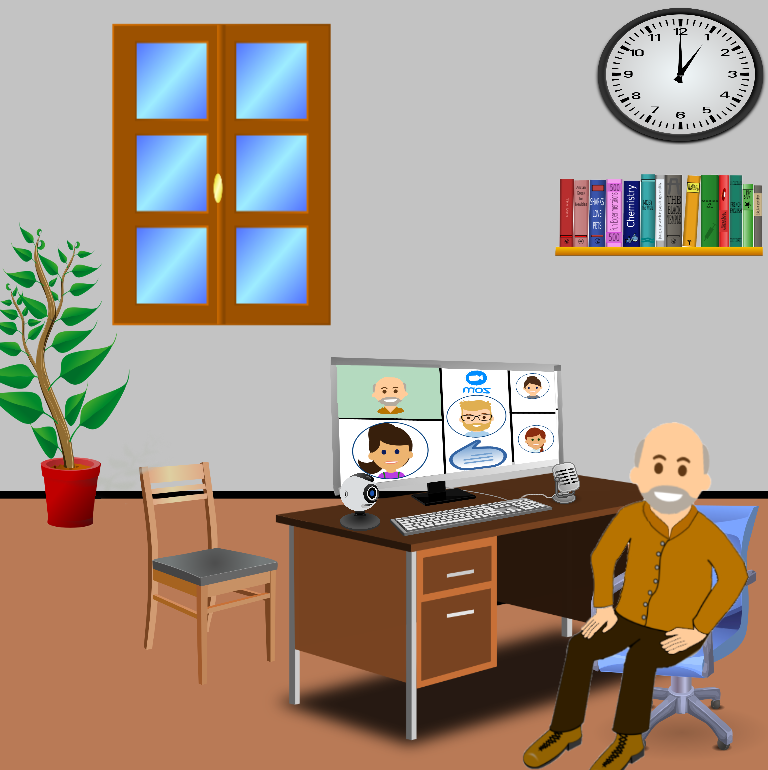
Wie unter 2.2 beschrieben meint Distanzlehre eine reine Digitallehre, die synchron (=live) und/oder asynchron (orts- und zeitunabhängig) gestaltet werden kann.
In der Praxis finden sich häufig "Mischformen" vor, bei denen ein asynchroner Kurs mit Lehr- und Lernmaterialien/-aufgaben als Basis und zur Vorbereitung dient und Teile der Vermittlung sowie Vertiefung dann online (z.B. in mehreren Videokonferenzen) durch Lehrende stattfinden.
Der Anteil und die Umfänge einer Digitallehre werden u.a. durch Curricula der Institution vorgegeben.
Nachfolgend sollen nochmal Besonderheiten und Herausforderungen solcher Szenarien (sowohl bei synchroner, als auch asynchroner Vermittlung) zusammengefasst werden.Nutzen Sie für tiefergehende Information zur Konzeption bitte unseren Kurs zum Didaktischen Design von Lehrveranstaltungen [21.03.2023] -
Synchrone Vermittlung über Videokonferenz
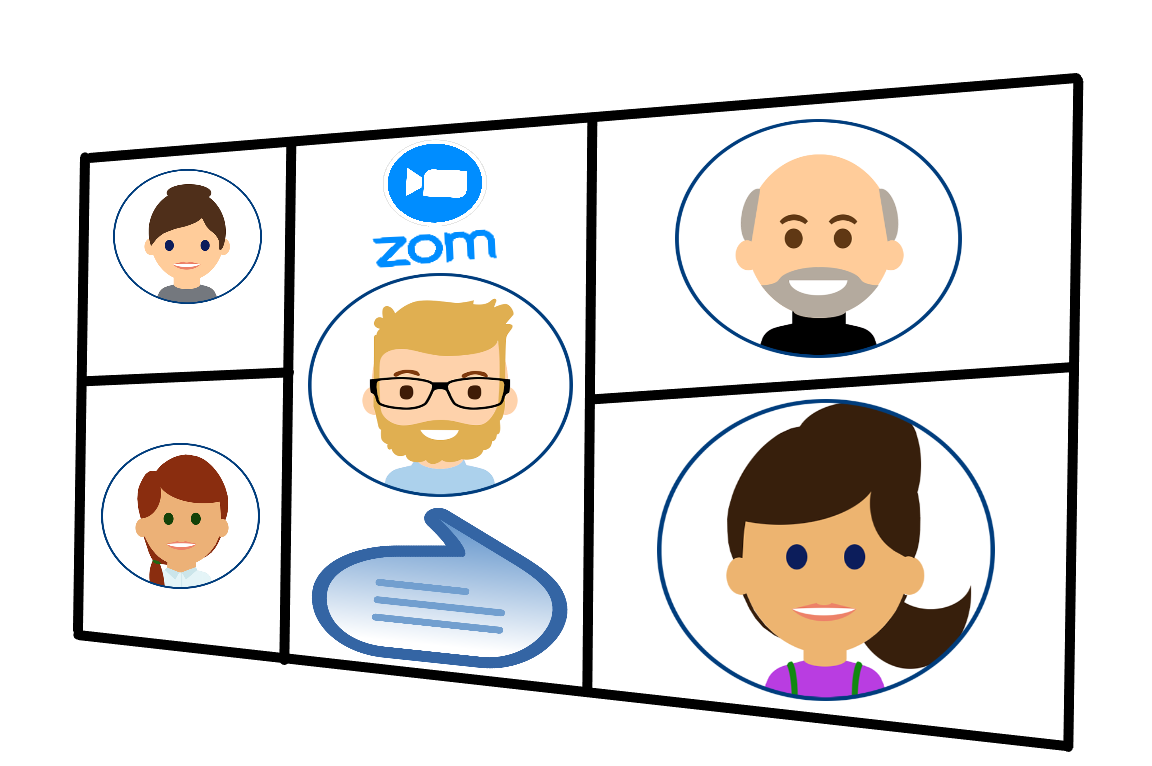 Wenn
Sie eine Veranstaltung online mit Hilfe eines Videokonferenzdienstes
(z.B. Zoom) durchführen, so gilt es gewisse Herausforderungen und
Fragestellungen vorab zu klären bzw. diese in Ihre Konzeption
miteinfließen zu lassen.
Wenn
Sie eine Veranstaltung online mit Hilfe eines Videokonferenzdienstes
(z.B. Zoom) durchführen, so gilt es gewisse Herausforderungen und
Fragestellungen vorab zu klären bzw. diese in Ihre Konzeption
miteinfließen zu lassen. Grundsätzlich sind Sie als lehrende Person relativ frei in der Gestaltung und Durchführung solcher Szenarien, dennoch gibt es Erfahrungswerte und Empfehlungen, die Ihnen nachfolgend als eine Art Orientierung und Hilfestellung dienen sollen...
Grundsätzliche, konzeptionelle Überlegungen und Best-Practice Beispiele für eine Umsetzung solcher Szenarien und zur Beantwortung der unten aufgeführten Fragen finden Sie in unserem Kurs zum Didaktischen Design [21.03.2023] -
Checkliste / Fragestellungen synchrone Lehre
Checkliste:
Haben Sie Ihre Online-Veranstaltung in Phasen mit Lehr- und Lernzielen unterteilt?Schließt die Veranstaltung nachvollziehbar und transparent an vorherige Lehr- und Lernszenarien an?Wie stellen Sie sicher, dass alle Teilnehmenden auch Zugang zur Veranstaltung haben?Sind die technischen Voraussetzungen für eine reibungslose Durchführung gegeben?Wie stellen Sie sicher, dass Teilnehmende sich aktiv einbringen können (Fragen/Rückmeldungen)?Wie gestalten Sie mögliche Gruppenarbeiten und Aufgaben?Wie möchten Sie Lernergebnisse / Lösungen (von z.B. Gruppenarbeiten) dokumentieren bzw. archivieren?Nutzen Sie eine Art von Co-Moderation und wie organisieren Sie diese?Nutzen Sie Audience Response Systeme und wenn ja wie und an welcher Stelle?Möchten Sie die Veranstaltung aufzeichnen und wenn ja: Beachten Sie diesbzgl. die DSGVO?Wie erheben Sie Feedback und stellen Sie sicher, dass alle Fragen beantwortet werden?Welche Kontaktmöglichkeiten stellen Sie generell für Nachfragen und/oder Anmerkungen zur Verfügung? -
Asynchrone Vermittlung von Lehr- und Lerninhalten
 Wenn Sie Lehr- und Lernmaterialien, spezifische Aufgaben und z.B.
Wissensüberprüfungen über einen begleitenden Online-Kurs auf einem
Learning-Management-System (LMS) zugänglich machen, so gilt es hierbei
auch einige Punkte zu beachten.
Wenn Sie Lehr- und Lernmaterialien, spezifische Aufgaben und z.B.
Wissensüberprüfungen über einen begleitenden Online-Kurs auf einem
Learning-Management-System (LMS) zugänglich machen, so gilt es hierbei
auch einige Punkte zu beachten.Neben Aufbau, Struktur und der Aufbereitung der Lehr- und Lerninhalte sollten z.B. auch Kontakt-/ Diskussionsmöglichkeiten sowie interaktive Elemente mitgedacht werden.
Einstellungen, Werkzeuge und sonstige Gestaltungsoptionen für Ihren Moodle-Kurs finden Sie in aller Tiefe hier erläutert [22.03.2023] -
Checkliste / Fragestellungen asynchroner Lehre
Grundlegende Fragen/Hinweise:
Entsprechen die allgemeinen Kurseinstellungen (Zugang, Gruppen etc.) den Vorgaben bzw. Ihrem Bedarf?Wann und in welchem Zeitraum soll der Kurs für wen genau zugänglich gemacht werden?Haben Sie eine klare Struktur und inhaltliche Orientierung im Kurs implementiert?Gibt es Kontaktmöglichkeiten im Kurs bzw. welche wollen Sie hier nutzen (z.B Forum/Chat)?Sind die einzelnen Abschnitte und Kapitel übersichtlich gegliedert (Inhaltsangabe)?Bauen die einzelnen Abschnitte schlüssig aufeinander auf (roter Faden)?Sind die Formatierungen einheitlich und im Idealfall auch im "Corporate Design"?Wie stellen Sie mediale Inhalte zur Verfügung (Audio / Video / Dokumente etc.)?Sind die genutzten Medien lizenzrechtlich einwandfrei nutzbar und entsprechend gekennzeichnet?Sind interaktive Elemente (z.B. H5P-Inhalte) integriert?Stellen Sie zusätzliche Vertiefungen & Informationen zur Verfügung (z.B. über Links & Literatur)?Nutzen Sie Glossare?Sind Wissensüberprüfungen enthalten und wie werden diese genau umgesetzt / genutzt?Wie stellen Sie sicher, dass Teilnehmende des Kurses über Neuigkeiten / Ergänzungen informiert werden?Informieren Sie sich bitte über die vielfältigen Möglichkeiten der Gestaltung & Einstellungen eines Kurses auf moodle hier [21.03.2023]
-
-
Wenn man die Elemente des E-Learnings genauer betrachtet, so unterscheidet man hierbei in folgende vier Merkmale
- Interaktivität: Benutzer hat Steuerungsmöglichkeiten; aktive Teilnahme
- Multimodalität: verschiedene Sinnesmodalitäten (auditive/visuelle Informationsaufnahme)
- Multicodalität: Darbietungsform (Codierung) bestimmter Informationen (Bild, Video)
- Multimedialität: Die Vielzahl an eingesetzten Medien (Bücher, Audio, Video, Computer
Nachfolgend sollen diese Merkmale von E-Learning-Arragements vorgestellt werden:
-
3.1 Multimedial, -codal und -modal

E-Learning beinhaltet die Nutzung einer Vielzahl von Medien und entsprechenden Eigenschaften um Lehr- und Lerninhalte aufzubereiten, darzustellen und zu veröffentlichen. Nachfolgend werden diese kategorisiert bzw. die Begrifflichkeiten dazu erläutert:
Multimedial
...bezieht sich dabei immer auf einen konkreten Anwendungsbezug: in welchem Arrangement/Setting werden über verschiedene Coderungen von Informationen bestimmte Sinne der Lernenden angesprochen.Für Klimsa umfasst: „[...] „Multimedia" zahlreiche Hardware- und Softwaretechnologien für Integration von digitalen Medien, wie beispielsweise Text, Pixelbilder, Grafik, Video oder Ton. Neben diesem Medienaspekt – Multimedialität – spielen aber auch Interaktivität, Multitasking (gleichzeitige Ausführung mehrerer Prozesse) und Parallelität (bezogen auf die parallele Medienpräsentation) eine wichtige Rolle. In diesem Zusammenhang können wir vom Integrations- und Präsentationsaspekt des Multimediabegriffs sprechen“ (2002: 3).Multimedia im Sinne von E-Learning steht häufig auch im Zusammenhang mit dem Begriff der "neuen Medien":Ratzke meint mit neuen Medien „[...] alle Verfahren und Mittel (Medien), die mit Hilfe neuer oder erneuerter Technologien neuartige, also in dieser Art bisher nicht gebräuchliche Formen von Informationserfassung und Informationsbearbeitung, Informationsspeicherung, Informationsübermittlung und Informationsabruf ermöglichen“ (1982: 14).Multicodal
...als Eigenschaft heißt verbal und/oder mit Bildern, Graphiken oder Zahlen.Multicodal meint die Verwendung mehrerer Zeichensysteme (Wort, Zahl, Bild) (vgl. Weidemann, 2002).Es wird ein Zusammenhang zwischen der Verfügbarkeit von Wissen und der über die Codierung angesprochenen Sinne vermutet. Man behält z.B. einen Text in Verbindung mit einem Bild u.U. besser, da stärkere, mentale Verknüpfungen und Repräsentationen des Gelernten gebildet werden. Allerdings setzt dies immer ein entsprechendes didaktisches Design und keine Überlastung der Sinne voraus.
Multimodal
...meint die Stimulation mehrerer Sinnesorgane (Sehen, Hören, Riechen, Schmecken und Tasten) bei Lernenden.
Es beschreibt eine Kommunikationsmethode, die auf textlichen, auditiven, sprachlichen, räumlichen und visuellen Modalitäten (lat. Art und Weisen) basieren kann.
Bruns & Meyer-Wegener (2005: 20): „Eine Information heißt multimodal, wenn sie auf mindestens zwei Rezeptorklassen verteilt übermittelt wird. In allen anderen Fällen spricht man von einer monomodalen Information." -
3.2 Interaktivität
 Interaktion, also die aktive Partizipation der
Teilnehmer*Innen eines Kurses, beschreibt letztlich einen
Kommunikationsprozess, der kooperatives und kollaboratives Lernen im sozialen
Kontext fördern kann.
Interaktion, also die aktive Partizipation der
Teilnehmer*Innen eines Kurses, beschreibt letztlich einen
Kommunikationsprozess, der kooperatives und kollaboratives Lernen im sozialen
Kontext fördern kann.Allerdings kann eine Interaktion auch mit dem Medium selbst, über z.B. Lernprogramme, Simulationen und individuelle Designs gestaltet werden. Die Lernenden bekommen eine aktive Rolle zugewiesen, indem sie interagieren (untereinander und/oder mit dem System) und über konkrete Handlungen und Entscheidungen Einfluss auf die Lernsituation selbst bzw. den weiteren Verlauf des Lernprozesses nehmen.
In diesem Abschnitt sollen Möglichkeiten von interaktiven Lehrbausteinen zusammengefasst werden:
Interaktion in Videokonferenzen / Online Kursen:
Fragen einbauen und Teilnehmer*Innen gezielt ansprechen/involvieren:Es kann hilfreich im Sinne der Aufmerksamkeit und der Motivation sein, die Interaktion über Fragestellungen an die Lernenden zu fördern. Konkrete Thesen, Probleme und Herausforderungen können dabei Neugier und Interesse am Lernthema verstärken.Audience response systeme (ARS) nutzen:Meinungen, Umfragen und Einschätzungen können mittlerweile über verschiedene Tools, die zumeist schon in der Software integriert sind, abgefragt und direkt ins Unterrichtsgeschehen aufgenommen werden.Eine Auswahl an technischen Lösungen für entsprechende ARS-System bzw. Abstimmungstools finden Sie hier!Praxisteile integieren / Referate:Praktische Elemente, wie z.B. Referate und Übungaufgaben, einzeln und/oder in Gruppen, eine anschließende Vorstellung, Diskussion und Reflexion vertiefen die Thematik, fordern die Lernenden stärker sich mit dem Lerninhalt auseinanderzusetzen und können den sozialen Austausch fördern.Hierzu eignen sich in Videokonferenzen sogenannte "Break-Out-Rooms", in denen eine festgelegte Zahl an Teilnehmenden in Kleingruppen arbeitet und diskutiert. Die Ergebnisse werden dann anschließend im Hauptmeeting vorgestellt und analysiert.Integrierte Reaktionen:Die Möglichkeit, über verschiedene Icons, Signale oder Grafiken dem Lehrenden und anderen Kursteilnehmer*Innen unmittelbare Rückmeldung zum Inhalt zu geben. Handzeichen oder Smileys sind z.B. ein schnelles und einfaches Mittel ein kurzes Meinungsbild einzuholen oder das Verständnis der Teilnehmenden zu überprüfen. Hier sollten Regeln dazu vorab festgelegt werden und die Verwendung entsprechender Symbole erklärt werden, um eine Überfrachtung von Symbolen im Kurs zu vermeiden und diese z.B. nur nach Aufforderung durch den Lehrenden angewandt werden dürfen.Abwechslungsreiche Struktur:Um die Aufmerksamkeit, das Interesse und die Aktivität hochzuhalten, bieten sich verschiedene Phase mit unterschiedlichen Anforderungen im Online-Kurs an. Neben reinen theoretischen Phasen, sollte nach wenigen Minuten immer auch ein aktivierendes Element integriert werden. Dies könnten u.A. Umfragen, konkrete Probleme/Fragestellungen, Arbeitsaufträge oder Gamification-Elemente sein. Das Gehirn wird somit auf verschiedenen Art und Weisen gefordert, man verfällt in keinen kognitiven Standby-Modus und die Lernenden sind keine reinen Rezipienten des Lerninhaltes, sondern werden aufgrund der Struktur aktiv eingebunden.Vielfalt der Kanäle und Medien nutzen:Abwechslungsreich lehren und vermitteln meint u.a. auch unterschiedliche Kanäle, Aufgabentypen und Darstellungsformen zu wählen. Die Lernenden sollten dabei nicht überfordert und reizüberflutet werden, aber eine gute Balance zwischen eingesetzten Medien und Kanälen kann Motivation und Aufmerksamkeit gewährleisten.
-
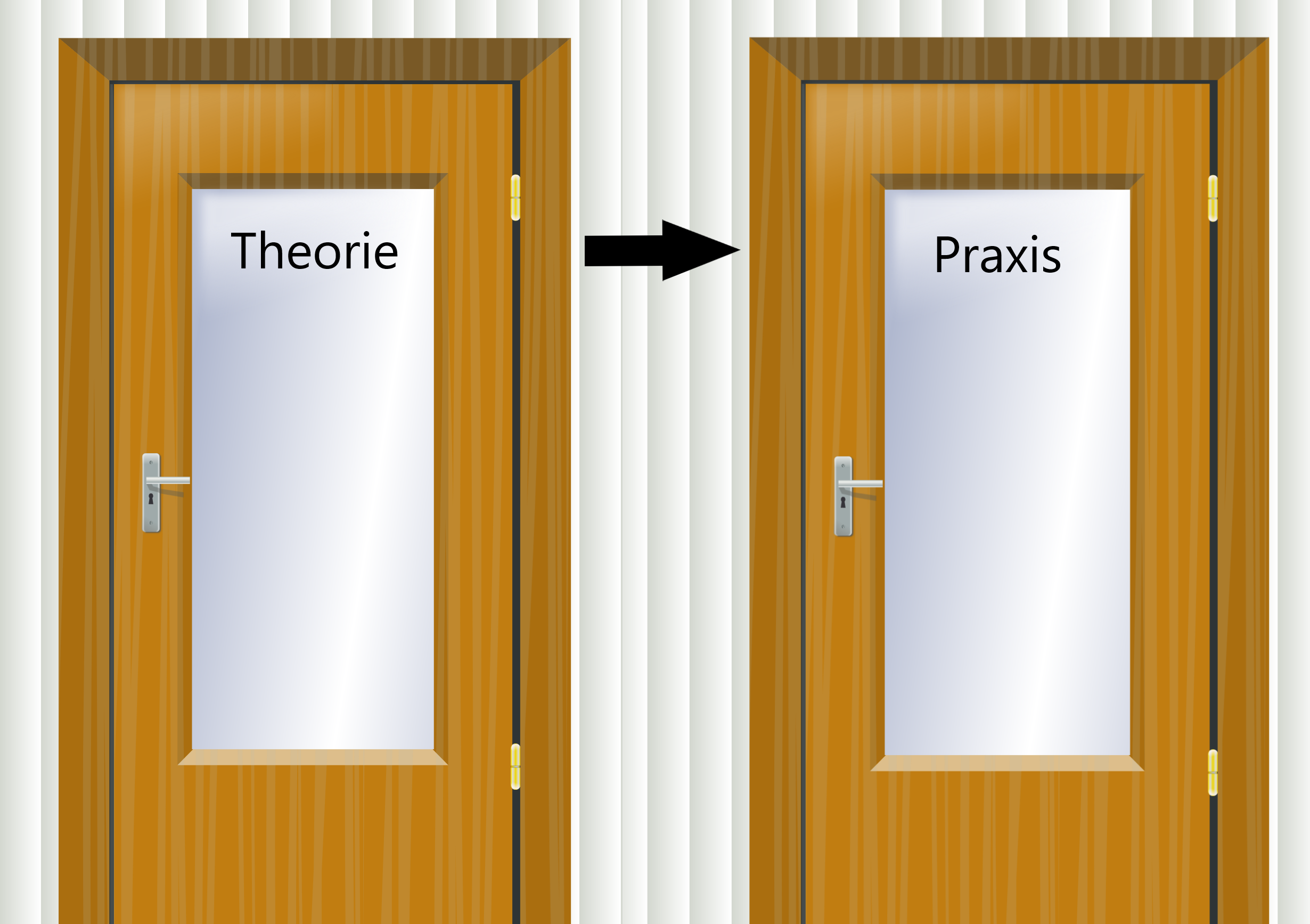 Wie kann eine Transformation von theoretischen Grundlagen der digitalen Lehre in konkrete Lehrszenarien gelingen?
Wie kann eine Transformation von theoretischen Grundlagen der digitalen Lehre in konkrete Lehrszenarien gelingen?Hier sollen die bisher vorgestellten Erkenntnisse und Theorien in eine Praxis überführt werden.
Lehrende sollen zunächst aufgezeigt bekommen, welche Prinzipien und Modelle sich für digitale Lehr- und Lernszenarien eignen und sich empirisch bewährt haben.
Darüber hinaus sollen ebenfalls motivationale und emotionale Aspekte des Lernens und entsprechender Lernarrangements vorgestellt und bewertet werden.
-
4.1 Prinzipien des multimedialen Lernens
Die nachfolgend vorgestellten Prinzipien basieren auf zahlreichen Untersuchungen zur kognitiven Theorie des multimedialen Lernens von Richard E. Mayer (2001) und dienen als Hilfestellung zur Gestaltung von E-Learning-Szenarien und entsprechenden Lehr-Arrangements.Das theoretische Modell und die zugrundliegenden Annahmen finden sich im Kurs Didaktik und Mediendidaktik! Prinzipien multimedialen Lernens:
Prinzipien multimedialen Lernens:- Kohärenzprinzip
Weniger ist mehr: Nur relevante, abgestimmte Inhalte präsentieren, die die Lernenden nicht überfordern und ihr Interesse wecken!- Kontiguitätsprinzip I
Zusammenhängende Wörter und Grafiken sollten nahe beieinander platziert werden, erläuternder Text z.B. in einer Abbildung!- Kontiguitätsprinzip II
Simultane Präsentation / Darstellung von Informationen (sprachlich und visuell) fördert den Wissenserwerb!- Multimediaprinzip
Texte und Bilder bzw. Animationen wirken in Kombination effektiver auf Lernprozesse, als nur textuelle Informationen!- Modalitätsprinzip
Die audiovisuelle Informationsaufnahme ist kognitiv weniger fordernd und wirkt effektiver als geschriebener Text zu einem Bild!- Redundanzprinzip
Unnötige, kognitive Belastungen sollten vermieden werden (z.B. gesprochener Text und dazu noch Abbildung des Textes)!- Personalisierungsprinzip
Computer als pädagogischer Agent; Ansprache, Instruktion und Interaktion helfen bei individuellem Design den Lernenden; -
4.1.2 Lehr- und Lernvideos
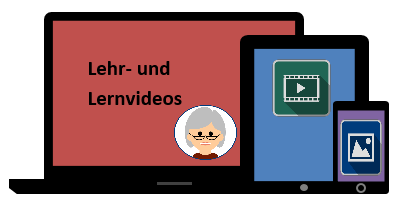 Videos und Aufzeichnungen sind in der
Lehre ein beliebtes Mittel, um Inhalte dem Lernenden flexibel, zeit- und ortsunabhängig (z.B. über eine Lernplattform) zur Verfügung zu stellen.
Videos und Aufzeichnungen sind in der
Lehre ein beliebtes Mittel, um Inhalte dem Lernenden flexibel, zeit- und ortsunabhängig (z.B. über eine Lernplattform) zur Verfügung zu stellen. Die Lernenden haben hierbei die Möglichkeit, sich Inhalte in ihrem Lerntempo anzueignen, indem sie die Clips herunterladen und vor- oder zurückspulen können.
Oftmals werden inhaltliche Grundlagen (z.B. der Vorlesung) einer Fachrichtung u. A. in solchen Clips aufbereitet und den Studierenden für das Selbststudium über eine Lernplattform bereitgestellt.
"Onlinevideos sind alltäglich und breitgefächert genutzte Lernobjekte geworden, die Jugendliche im Internet suchen und für ihr eigenes alltägliches und schulisches Lernen verwenden" (Rummler & Wolf, 2011: 265).Es gilt jedoch auch hierbei wichtige Erkenntnisse bei der Vermittlung von Inhalten über das Medium Video zu beachten (siehe auch 1.1.2 Pinguin-Metapher). Nachfolgend sollen einige zentrale Studienergebnisse zur Thematik zusammengefasst werden:
Studienlage
Kim et al. (2014) fanden unter anderem heraus, dass die Länge von Lehr-Videos nicht mehr als 6 Minuten betragen sollte.
Eine repräsentative, internationale Studie der Firma simpleshow (2016) bestätigt diese These und konstatiert einer Videolänge von bis zu 3 Minuten besonders gute Lerneffekte.
Die Wahrscheinlichkeit der Betrachtung sinkt mit der zeitlichen Länge eines Videos, zudem ist die Aufmerksamkeitsspanne tendenziell abnehmend und dem Faktor Zeit wird zukünftig mehr Bedeutung beigemessen.Darüber hinaus empfiehlt es sich auf zu viele Effekte und zu bunte Videos (im Sinne der Lerneffektivität )zu verzichten (vgl. ebd.).
Es wird zukünftig nicht der absolute Lernerfolg einer Videoeinheit entscheidend sein, sondern vielmehr die Zeit, in der dieser Lernerfolg erreicht wird.Lediglich 55% instruktionaler Videos werden bis zum Ende angesehen (vgl. Kim et al., 2014).
Eine längere Betrachtung korreliert mit der Sichtbarkeit der Lehrperson im Video (ebd.), da die Aufmerksamkeit der Lernenden durch ein Gesicht positiv beeinflusst wird (vgl. Kizilcec, 2014). Auf den Lernerfolg hat die sichtbare Lehrperson jedoch keine signifikante Auswirkung (ebd.).
Eine weitere Studie belegte darüber hinaus, dass Lernende "[...]theoriebasierte Videos im Lecture Style, also mit sichtbarer Lehrperson, präferieren und bei gleichzeitiger Erhöhung der Lernmotivation zu besseren Lernergebnissen tendieren." (Sailer & Figas, 2015: 94).
Videos / Clips können auch emotionale und motivationale Funktionen beeinflussen, durch z.B. Gestik und die Stimme des Lehrenden.Gestiken und andere Signalingmethoden sind im Video hilfreich und lenken den Fokus der Lernenden (vgl. Dargue, Sweller, 2020).
Interaktive Videos steigern signifikant das Interesse und führen zu stärkerem Wissenszuwachs!Eine Studie (Schneider et al., 2016) konnte aufzeigen, dass Interaktionen innerhalb eines interaktiven Erklärfilms einen Einfluss auf das thematische Interesse der Lernenden haben und zudem zu einem stärkeren Wissenszuwachs führen als Medien ohne Interaktionen!Quizzes, Multiple Choice Aufgaben, Zuordnungsübungen und/oder Gamification sind nur wenige Beispiele für Interaktivität in Videos!Eine erhöhte Abspielgeschwindigkeit (1,5-/2fach) beeinflusst das Verständnis und die Lerneffizienz übrigens kaum. Dies ermöglicht den Lernenden ihre Lernzeit ökonomisch einzuteilen, da nicht zuletzt aufgrund der Vielzahl digitaler, asynchron bereitgestellter Videos Lernzeit strategisch eingesetzt werden kann (Quelle: https://www.forschung-und-lehre.de/lehre/mit-doppelter-geschwindigkeit-durch-die-vorlesung-4361 [26.01.2022]).
-
4.2 Lernen und Motivation

Das Lernen und Motivation zusammenhängen klingt logisch und doch erfährt diese Beziehung relativ wenig Berücksichtigung bei der Konzeption und dem Design von digitalen und/oder hybriden Lehrszenarien.
Gerade in Zeiten selbstgesteuerten Lernens und aufgrund vermehrter, orts- und zeitunabhängiger Lernprozesse erfährt die Bedeutung motivationaler Aspekte für die Lehre und das Lernen eine neue Relevanz.
Es gilt daher die motivationalen Aspekte zu beleuchten und einen Transfer in die vielfältigen Möglichkeiten von Settings der digitalen Lehre aufzuzeigen.
Zunächst soll eine grundlegende Differenzierung von Motivationsarten vorgenommen werden, um dann Transfereffekt auf heutige Lehrszenarien zu veranschaulichen.
Neugier am Lerninhalt und der Anwendung zu wecken, sollte hierbei stets als übergeordnete Zielsetzung dienen und als Herausforderung für didaktisch inszenierte Lehrformate verstanden werden.
Welche Arten von Motivation sind wichtig zu kennen und was zeichnet diese aus?Intrinsische vs. Extrinsische Motivation
Eine differenzierte Betrachtung bestimmter Verhaltensweisen von Individuen erfordert eine Auseinandersetzung und ein Verständnis von intrinsischer und extrinsischer Motivation (vgl. Renninger, Hidi, Krapp, 1992).
Vereinfacht gesagt unterscheiden manche Autoren in selbstbestimmte (intrinsische, aus innerer Neugier und eigenem Interesse erzeugte) Handlungen sowie nicht-selbstbestimmte (extrinsische, von außen über Anreize erwirkte) Handlungen (vgl. Deci, Ryan, 1993). Intrinsische und extrinsische Motivation sind nicht als genereller Gegensatz zu verstehen, da beide Arten sich auch gegenseitig bedingen bzw. beeinflussen.
Beispielsweise kann jemand der für eine bestimmte Aufgabe keine besonders hohe intrinsische Motivation aufweist, durch externe Reize (wie z.B. ein Lob oder einer Belohnung) eine höhere intrinsische Motivation als Folge entwickeln. Allerdings kann damit auch eine Erwartungshaltung geweckt werden, die eine intrinsische Motivation nur über entsprechend wiederkehrende, externe Reize gewährleistet.
Darüber hinaus scheinen sich laut weiterer Untersuchungen intrinsische und extrinsische Motivation in einer Art positiven Wechselwirkung zu beeinflussen (Stajkovic & Luthans, 2003; Cerasoli, Nicklin & Ford, 2014).
Deci (1993: 226) kritisierte in diesem Zusammenhang, dass „[…]die Einführung extrinsischer Motivatoren in den Handlungsablauf einer intrinsisch motivierten Tätigkeit das Gefühl der Selbstbestimmung unterminiert.“In einer Metaanalyse kamen Cameron et al. (2001) allerdings zu dem Ergebnis, dass extrinsische Belohnungen meistens einen positiven Effekt auf die intrinsische Motivation besitzen. Dies wurde vor allem dann deutlich, wenn die Belohnung für die erbrachte Leistung und nicht für ein bestimmtes Verhalten erfolgte.Wie können Sie nun Motivation generell in Lehr- und Lernszenarien fördern?
Allgemeine Empfehlungen um Motivation und Aktivierung im Unterricht zu fördern:Problemorientierter Ansatz: Stellen Sie Ihren Studierenden aktuelle und relevante Probleme aus der Praxis vor und fordern Sie sie auf, Lösungen zu entwickeln.
Teamarbeit: Ermöglichen Sie Ihren Studierenden, in Teams zu arbeiten, um soziale Interaktionen und Unterstützung zu fördern und die Verantwortung für das Lernen zu teilen.
Selbstbestimmtes Lernen: Geben Sie Ihren Studierenden die Möglichkeit, ihre eigenen Lernprozesse und Ziele zu gestalten, um die Motivation und die Verantwortung für das Lernen zu erhöhen.
Einbeziehung von Technologien: Nutzen Sie moderne Technologien wie Lernmanagement-Systeme, virtuelle Realität oder Simulationen, um über z.T. innovative Methoden eine Aktivierung der Studierenden zu fördern.
Projektbasierter Ansatz: Planen Sie Projekte, die die Anwendung des Gelernten ermöglichen und die Studierenden zu aktiver Mitarbeit ermutigen und ein konkretes Ergebnis als Ziel haben.
Flipped Classroom: Nutzen Sie die Zeit im Hörsaal/Seminar, um die Anwendung des Gelernten zu üben und lagern Sie Grundlagenwissen und vorbereitende Übungen auch auf die Selbstlernzeit aus
Feedback: Geben Sie regelmäßig Feedback, um Ihre Studierenden über ihre Fortschritte und Erfolge zu informieren, Transparenz herzustellen und ihre Motivation aufrechtzuerhalten.
Herausforderungen erzeugen Bedeutung, daher gilt es....
...maßvolle, aber fordernde Aufgaben zu konstruieren:
Balance zwischen Anspruch der Aufgaben und Vorkenntnissen der Lernenden!
...kritisches Denken anzuregen und Kreativität zu fördern:
Z.B. bei der Lösung von Problemen und Fragestellungen! Neugier wecken als starke intrinsische Triebfeder;
...Hilfsbereitschaft der Lernenen zu fördern:
Lernende möchten sich einbringen, gegenseitig unterstützen und können dabei intrinsische Motivation steigern:
...Kontrolle auch abzugeben:
Selbstständigkeit beim Lernen fördern; Eigene, individuelle Lernpfade ermöglichen und Verantwortung übertragen
...Anerkennung Raum zu geben:
Loben Sie dosiert und geben regelmäßig Feedback; Stärken der Lernenden hervorheben!
(vgl. https://elearningindustry.com/sources-intrinsic-motivation-elearning-pros-consider [15.11.2021])
-
4.2.1 ARCS-Modell
 1987 entwickelte John Keller sein Modell ARCS, welches ein Instruktionsdesign für E-Learning aus motivationaler Sicht darstellt.Es wird in diesem Modell in vier Kategorien differenziert, die alle Einfluss auf die Motivation von Lernenden besitzen. Zuvor wurde ja bereits die Bedeutsamkeit und die Zusammenhänge von Motivation und Lernen erörtert.Nachfolgend wird aus Gründen des Verständnisses die deutsche Übersetzung des Akronyms verwendet!Erklärung der Begriffe:1. Aufmerksamkeit erlangen (Attention)
1987 entwickelte John Keller sein Modell ARCS, welches ein Instruktionsdesign für E-Learning aus motivationaler Sicht darstellt.Es wird in diesem Modell in vier Kategorien differenziert, die alle Einfluss auf die Motivation von Lernenden besitzen. Zuvor wurde ja bereits die Bedeutsamkeit und die Zusammenhänge von Motivation und Lernen erörtert.Nachfolgend wird aus Gründen des Verständnisses die deutsche Übersetzung des Akronyms verwendet!Erklärung der Begriffe:1. Aufmerksamkeit erlangen (Attention)
2. Relevanz, Bedeutsamkeit des Lehrstoffes vermitteln (Relevance)
3. Erfolgszuversicht (Confidence)
4. Zufriedenheit, Befriedigung (Satisfaction)1. Aufmerksamkeit / Attention:
Bezogen auf multimediale Lehrszenarien ist es ratsam, neue, nicht erwartete, teils widersprüchliche Inhalte den Lernenden (auch in Form einer These oder Fragestellung) zu präsentieren, die Aufmerksamkeit damit zu wecken und/oder eine Diskussionen auszulösen.Auf der technischen Ebene lässt sich dies z.B. durch audiovisuelle Effekte, Animationen, Töne oder Sprache erzeugen. Hierbei sollte allerdings keine Effekthascherei betrieben, sondern die für das Thema wesentlichen Inhalte präsentiert werden. Auch provokative/widersprüchliche Bilder und Aussagen können Aufmerksamkeit generieren, so lange die Intensität der Inhalte angemessen erscheint.Eine abwechslungsreiche Darstellung, z.B. ein Wechsel von interaktiven Elementen und einer reinen Präsentation von Inhalten, erweist sich ebenfalls als günstig im Sinne der Aufmerksamkeit. Auch eingestreute Fragestellungen und Probleme regen die Auseinandersetzung mit der Thematik an und können intrinsische Motivation fördern.2. Relevanz / Relevance:
Motivation entsteht ebenfalls, wenn dem Lerninhalt Bedeutung zugeschrieben wird und dies den Lernenden bewusst wird. Gerade auch die konkrete Verknüpfung des Lerninhaltes mit dem Lernziel lässt die Relevanz deutlich werden und sorgt für Transparenz. Kooperative und kollaborative Lernszenarien (im Sinne bestimmter Lernziele) vermitteln aufgrund konkreter Rollen und Aufgaben eine gewisse Verbindlichkeit und erlangen Bedeutung. Regelmäßiges Feedback und Reflexionsphasen erhöhen die Bindung, reduzieren Drop-Outs und motivieren sich den nächsten Schritten und Aufgaben zu stellen. Es ist den Lernenden somit wichtiger dran zu bleiben und sich zu verbessern.3. Erfolgszuversicht / Confidence:
Im Kern geht es darum, den Lernenden Selbstvertrauen und eine positive Erwartung hinsichtlich des Lernprozesses und klar definierter Lernziele zu vermitteln. Transparenz und Eindeutigkeit der Lernziele und Bewertungskriterien schafft Bewusstsein und baut Vertrauen auf. Vorherige Informationen zu benötigten Vorkenntnisse und Fertigkeiten unterstützen diesen Prozess und bieten Hilfestellung. Lerninhalte von Leicht zu Schwer zu vermitteln, Erfolgserlebnisse herzustellen und innerhalb heterogener Gruppen auch differenzieren zu können sind Eigenschaften des Lehrenden, die die Erfolgszuversicht bei Lernenden positiv beeinflussen können. Den Lernenden Verantwortung zu übertragen, Kontrolle über das eigene Lerntempo zu ermöglichen und individualisierte Lernpfade (z.B. auf einer Lernplattform) verstärken die beschriebenen Effekte.4. Zufriedenheit / Satisfaction:
Unzufriedenheit wirkt sich stark negativ auf die Motivation aus. Wird die Erwartungshaltung beim Lernenden enttäuscht, so stellt sich Demotivation ein und die Gefahr des Drop-Outs erhöht sich rapide. Es ist also aus Lehrendenperspektive geboten, durch regelmäßiges Feedback und Reflexionsphasen eine realistische Erwartungshaltung zu generieren und klare Transparenz hinsichtlich der Lernziele und Kriterien zu schaffen (wie z.B. beim Constructive Alignment). Motivational bietet es sich an, regelmäßige, abwechslungsreiche Übungen durchzuführen, damit die Lernenden ihr neu erworbenes Wissen in realen Situationen oder Simulationen anwenden und erproben können. Die Übungen sollten entsprechend dem Vorwissen und dem Kenntnisstand der Lernenden konzipiert werden, damit Frustration und Überforderung vermieden und die Erfolgszuversicht gesteigert wird. Angemessene Verstärkungen (Lob, dosierte Belohnungen, positive Rückmeldung) fördern die Zufriedenheit der Lernenden. -
4.2.2 Audience Response System (ARS)
Wie gelingt es Lernende in E-Learning Szenarien mehr einzubinden bzw. die Interaktivität zu erhöhen?Eine Möglichkeit, Lehr- und Lernszenarien im virtuellen Raum mit interaktiven Elementen anzureichern, besteht im Einsatz von Audience Response Systemen (ARS). Hierbei wird über hard- oder softwarebasierte Lösungen Feedback von den Teilnehmenden eines Kurses eingeholt und z.B. unmittelbar im Kurs selber integriert bzw. analysiert.
ARS meint i.d.R. Abstimmungsmöglichkeiten oder die Beanwortung von Multiple Choice Fragen innerhalb einer Präsentation oder eines Kurses!
Es kann diesbezüglich noch zwischen synchroner und asynchroner Kommunikation unterschieden werden, je nachdem welcher Veranstaltungstyp und welche Lehrorganisation von den Lehrenden gewählt wird.
Eine Übersicht zu einigen Tools, die man für beide Varianten nutzen kann, findet man in dieser Aufstellung sowie hier und natürlich in unserem Kurs zum Thema!Studienlage und Praxisbefunde
Der Einsatz von ARS Systemen erhöht die Aufmerksamkeit, da diese es den Lernenden ermöglichen sich stärker einzubringen (vgl. Kaleta & Joosten, 2007).Die Wissensvermittlung scheint bei Lernenden effektiver zu gelingen bzw. der Lernerfolg wird erhöht, wie eine Umfrage unter Lernenden ergab (vgl. ebd.).Die Anonymität der Interaktion erhöht die Partizipationsbereitschaft der Lernenden und involviert damit auch tendenziell zurückhaltende und schüchterne Lerner*Innen. Abweichende Positionen und andere Perspektiven fließen somit vermehrt in den Lehr- und Lernprozess ein.Aus Lernendensicht ermöglicht die Erfassung von Ergebnissen (z.B: bei Multiple Choice Fragen) eine Dokumentation über die eigenen Wissensstand und man kann damit eine gewisse Transparenz herstellen.Aus Lehrendensicht können ARS-Systeme helfen, die eigenen Inhalte und das Lehrtempo (synchron und asynchron) an die Rückmeldung der Lernenden anzupassen und damit zielgruppenspezifischer zu vermitteln. Mittel- und langfristig können durch die Dokumentation entsprechender Feedbacks wichtige Erkenntnisse über geeignete Vermittlungsmethoden und ggfls. fachspezifische Probleme gewonnen und mit anderen Lehrkräften ausgetauscht werden.ARS-System haben aufgrund ihres tendenziell innovativen Charakters und unterschiedlichen Integrationsformen einen gewissen Unterhaltungswert, der Interesse, Neugier und Motivation bei den Lernenden positiv beeinflussen kann. -
Tools & Anbieter
 In diesem Abschnitt werden wir bekannte (und vielleicht noch unbekannte) Tools & Anbieter verlinken, die sich auf das Thema Audience Response und Interaktivität in der digitalen Lehre spezialisiert haben.
In diesem Abschnitt werden wir bekannte (und vielleicht noch unbekannte) Tools & Anbieter verlinken, die sich auf das Thema Audience Response und Interaktivität in der digitalen Lehre spezialisiert haben.Hier finden Sie u.A. eine Aufstellung und Übersicht: https://ep.elan-ev.de/wiki/Audience_Response [15.07.2022]
Grundsätzlich sollten Sie bei einer Verwendung entsprechender Dienste vorab die aktuelllen, datenschutzrechtlichen Vorschriften prüfen und z.B. eine DSGVO-Konformität sicherstellen!
Darüber hinaus sind nicht alle Dienste kostenfrei bzw. in ihrer "Basis"-Variante in der Funktionalität zumeist beschränkt.
Je nach Anforderungen und individuellen Bedürfnissen ist die Funktionalität bestimmter Dienste entsprechend abzuwägen und in Abstimmung mit den eigenen Lehr- und Lernszenarien zu beurteilen.
Die Liste erhebt natürlich keinen Anspruch auf Vollständigkeit, wird aber immer wieder editiert und erweitert:
OnlineTED (aktuell im Rahmen einer Lizenz für Mitarbeitende und Lehrende der THGA/DBM verfügbar, Infos hier [16.03.2023])
-
4.2.3 Gamification
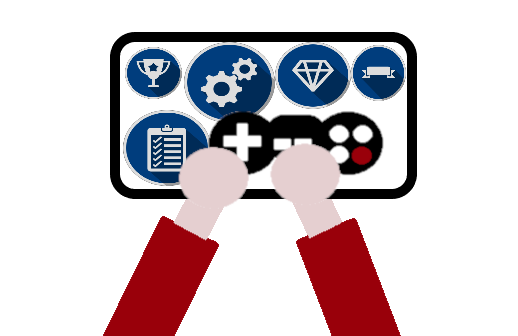
Gamification beschreibt die Verwendung von Elementen aus (Computer-)Spielen in einem Lehr- und Lernszenario. Ziel hierbei ist es die Motivation der Lernenden zu fördern und über z.B. Belohnungen oder sog. „Badges“, Bestenlisten und/oder Zertifikate eine erhöhte Lernaktivität und –motivation zu generieren.
In Abgrenzung zu Lernspielen werden gamification-Elemente zumeist in einem nicht spielbezogenen (Lern-)Kontext benutzt, bauen aber auf ähnlichen Prinzipien der Belohnung und Verstärkung auf.
Studienlage
Die Studienlage zeigt ein sehr heterogenes Bild, wenn es um die Effekte von gamification auf Lernleistung und/oder Motivation geht. Aufgrund der unterschiedlichen Einsatzszenarien und –methoden in Lehr- und Lernprozessen erweist sich eine Analyse der Potentiale von gamification als schwierig. Nachfolgend sollen einige Studien einem ersten Überblick zur Einordnung der Thematik dienen.
Aus motivationaler Sicht scheint es laut Studienlage entscheidend für Effekte von gamification zu sein, ob Lernende für eine bestimmte Aufgabe bereits intrinsisch motiviert sind. Besteht also bereits Neugier und Interesse, so sind externe Belohnungen tendenziell eher kontraproduktiv und verringern intrinsische Motivation (vgl. Hanus, Fox, 2015).
Als langweilig wahrgenommene Aufgaben können allerdings durch die Integration von gamification-Elementen bzw. durch externe Anreize die intrinsische Motivation beim Lernenden positiv beeinflussen (vgl. Cameron, Banko, & Pierce, 2001; Deci et al., 2001). Ähnliche Schlussfolgerungen bzgl. eines nachweisbaren, gesteigerten User-Engagements bei Lernprozessen, die spielerische Elemente beinhalten, finden sich bei Mohamad et al. (2018).
Weitere positive Effekte von gamification konstatieren manche Autoren bei Lernenden in puncto Zufriedenheit (durch die Erreichung bestimmter Ziele/Belohnungen) und Optimismus (Erfolgserlebnisse, Selbstbestimmtheit) (vgl. Osterroth, 2021).
Eine Studie zeigte grundsätzlich Effekte von Gamification auf alle 3 psychologischen Grundbedürfnisse (Kompetenz, Autonomie und soziale Eingebundenheit) (vgl. Xi, Hamari, 2019).
Lernförderliche Potentiale im Sinne einer Teilhabe scheint gamification aber auch im Bereich der Inklusion zu besitzen, wie ein Konzept für blinde und sehbehinderte Menschen darstellt (vgl. Jent, Janneck, 2018).
Gamification - Arten
Stöcklin (2017) gliedert Gamification in vier verschiedene Arten auf:Belohnungs-GamificationHier gehts es in erster Linie um Punkte, Badges (Abzeichen) und/oder Sammelobjekte, die die Lernenden über die Bewältigung von bestimmten Aufgaben sammeln können.Status-GamificationDer Status definiert sich über Ranglisten, Levels, Avatare oder Fortschrittsanzeigen etc.;Identifikations-GamificationEine bestimmte Storyline, Hierarchisierungsoptionen von Aktivitäten, Visualisierung bestimmter Themen/AktivitätenSelbstbestimmungs-GamificationFreie Wahlmöglichkeiten im Lernprozess, Kooperationen und Wettkämpfe, Herausforderungen, Fantasie und Neugierde weckenDie Unterteilung bzw. die unterschiedlichen Arten dienen nur einer Gliederung, sind jedoch nicht unabhängig voneinander zu sehen, da sie oftmals auch kombiniert auftreten können oder gewisse Schnittmengen haben! -
4.3 Lernen und Emotionen
 Ähnlich wie der zuvor beschriebene Zusammenhang zwischen Lernen und Motivation kommt auch emotionalen Aspekten bei Lernprozessen viel Bedeutung zu!
Ähnlich wie der zuvor beschriebene Zusammenhang zwischen Lernen und Motivation kommt auch emotionalen Aspekten bei Lernprozessen viel Bedeutung zu! Lehrstrategien in virtuellen Lernumgebungen dürfen nicht nur kognitive Lernprozesse im Design berücksichtigen, sondern sie müssen auch Raum bieten für emotionale und motivationale Kriterien.
Entsprechend sollen auch hier Anknüpfungspunkte für eine digitale und/oder hybride Lehre entstehen und Einfluss auf ein didaktisches Design haben.
Empfinden Lernende das soziale Klima in ihrer virtuellen Lernumgebung als positiv, dann erhöht sich in der Regel die empfundene Zufriedenheit und damit die Wahrscheinlichkeit des Lernerfolgs. Empathie und Zuwendung helfen den Lernenden, die z.T. als frustrierend empfundene Isolation zu vergessen und sich als Teil einer Interessengemeinschaft mit einem kollektiven Ziel, der persönlichen Weiterbildung, zu fühlen.
Das Ziel virtueller Lernumgebungen muss sein, aus kurzfristigem Interesse heraus den Wunsch nach einer langfristigen und nachhaltigen Beschäftigung mit einem Wissensgebiet zu generieren. Um dies zu erreichen, müssen die Lerneinheiten zu den Interessen und Fähigkeiten der Lerner passen.So müssen z.B. die Anforderungen an den Lerner mit anwachsendem Expertentum steigen, um das Interesse aufrechterhalten zu können und den Lerner herauszufordern. Passung ist ein entscheidendes Kriterium für Instruktionsqualität. Selbstgesteuertes Kompetenzerleben ermutigt den Lerner darin, sich auch zukünftig konzentriert und engagiert mit den Lerneinheiten zu beschäftigen und eigenständig Problemlösestrategien zu entwickeln: Lernende müssen lernen, eigene Maßstäbe zu setzen.
(Zens, U. (o.J.))
Emotionen nehmen tiefgreifenden Einfluss auf menschliches Denken und Handeln. Sie steuern unsere Aufmerksamkeit, formen unsere Motivation, beeinflussen Speicherung und Abruf von Information aus dem Gedächtnis und befördern oder reduzieren Selbstregulation und den Einsatz von Problemlösestrategien. Dies hat zur Folge, dass sie auch für Lernen und Leistung im Bildungskontext zentrale Stellgrößen darstellen (Pekrun, 2017: 215).Krapp (2005: 607) ergänzt, dass wahrscheinlich zwischen „[…]emotionalen und motivationalen Bedingungen des Lernens enge wechselseitige Abhängigkeitsbeziehungen[..]“ nachweisbar wären. -
4.4 Didaktisches Design
 Dem didaktischen Design kommt auch in der digitalen Lehre eine entscheidende Bedeutung zu, da abhängig von einer Abstimmung bestimmter Lehr- und Lernziele, der Lehrmethodik und einer entsprechenden Prüfungsform eine zielgruppengerechte Vermittlung von Lerninhalten gelingen kann.
Dem didaktischen Design kommt auch in der digitalen Lehre eine entscheidende Bedeutung zu, da abhängig von einer Abstimmung bestimmter Lehr- und Lernziele, der Lehrmethodik und einer entsprechenden Prüfungsform eine zielgruppengerechte Vermittlung von Lerninhalten gelingen kann.Hier sollen Modelle für ein didaktisches Design kurz vorgestellt und erläutert werden und Lehrenden dahingehend als Hilfestellung dienen.
Einen eigenen Kurs zur Thematik mit tiefergehenden Erläuterunten und Modellen finden Sie hier [07.03.2023]Einige ergänzende Informationen & Links zu der Thematik finden Sie auch hier! [07.03.2023] -
4.4.1 CCR Framework
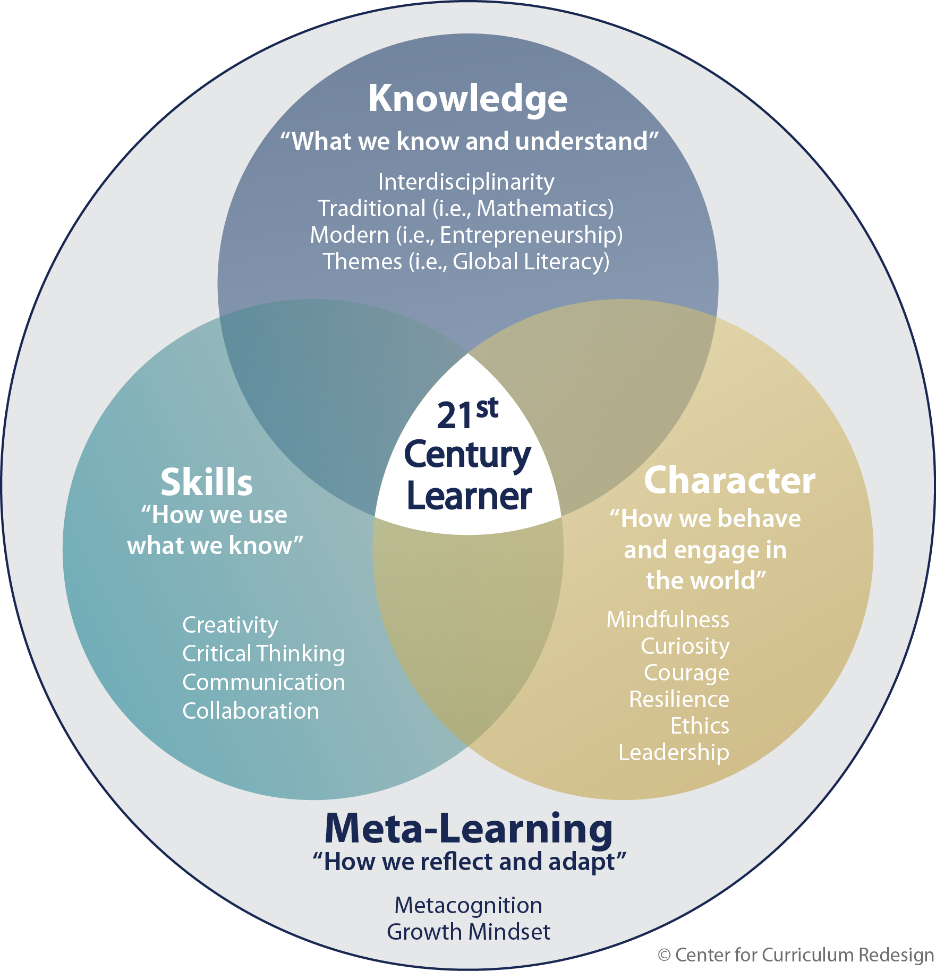
Quelle: https://curriculumredesign.org/ [01.12.2021]
CCR Framework
Was sollen Studenten im 21. Jahrhundert lernen?Diese Frage soll über das Modell CCR (Center for Curriculum Redesign) Framework (Fadel et al., 2015) zeitgemäß beantwortet werden und im Kern auf vier Dimensionen aufgeteilt werden: Wissen, Fähigkeiten, Charaktereigenschaften und Meta-Lernen.
Angemessenes Lernen, welches alle relevanten Dimensionen abdeckt, geschieht innerhalb derer Schnittmengen. Spannend hierbei ist die Ebene des Meta-Lernens, in der (als eine Art allumfassende Dimension) die Lernenden sich dem eigenen Lernen, dem Fortschritt und der Adaptation bewusst werden, diese reflektieren können und alle Lernprozesse entsprechend anpassen lernen.
Für Lehrende kann dieses Modell eine Hilfestellung sein, um eigene Lehrsettings innerhalb der Schnittmenge dieser Dimensionen verorten zu können, oder zumindest Teilaspekte einzelner Dimensionen im Hinblick auf die eigene Zielgruppe zu integrieren.
Die Dimensionen und ihr Zusammenspiel stellen gängige Curricula vor eine Herausforderung zur Anpassung, da hier die Schulentwicklung sowohl traditionelle, als auch innovative Ansätze des Lernens vereinen und an die gesellschaftliche Kommunikationskultur anpassen kann.
-
4.4.2 DigCompEdu
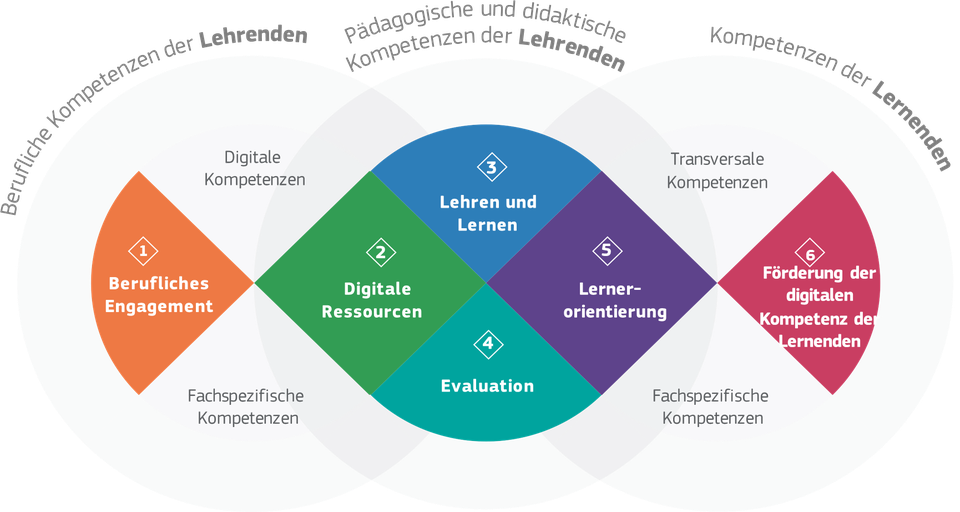
(c) European Union 2017 https://ec.europa.eu/jrc/en/digcompedu [01.12.2021]
DigCompEdu
Das mit der Grafik gezeigte Modell "DigCompEdu" der Europäischen Union soll einen europäischen Rahmen für eine bildungspezifische, digitale Kompetenzentwicklung von Lehrenden bzw. Pädagogen setzen.
Ziel des Modells: Digitale Technologien zur Verbesserung und Innovation von Bildung und Ausbildung zu nutzen!Sechs Kompetenzbereiche mit 22 Teilkompetenzen bilden den Kompetenzrahmen von DigCompEdu.
Die Bereiche 2 bis 5 bilden den Kern und beschreiben, wie Lehrende digitale Medien effektiv einsetzen können.
Dieser Kern wird flankiert von den Bereichen 1 und 6, wobei 1 die Lehrenden und ihre Kommunikation im beruflichen Umfeld thematisiert, im Bereich 6 hingegen die digitalen Kompetenzen der Lernenden im Fokus stehen.
Interessant an dem Modell ist ein Selbsteinschätzungstool für Lehrende, welches Aufschluss über die eigenen digitalen Kompetenzen und Fähigkeiten gibt, dieses findet sich hier!Kritisch zu sehen wäre an DigCompEdu die Notwendigkeit einer angemessenen Selbsteinschätzung und Selbstreflexion! -
4.5 Best Practice Beispiele
In diesem Video stellen wir Ihnen ausgewählte Projekte (sogenannte Best-Practice Modelle) vor, die Anregung und Hilfe für eine Gestlatung von digitaler Lehre sein können:
Darüber hinaus ist folgender Link für verschiedene Best-Practice Szenarien und Umsetzungsideen empfehlenswert: Institut für Lerninnovation [07.11.2023] oder in unserem Kurs zum Didaktischen Design [07.11.2023]
-
-
-
Quiz Terminus
-
-
-
Quellen
Bachmann, G., Bertschinger, A., Miluska, J. (2009): E-Learning ade – tut Scheiden weh? In: Apostolopoulos, N., Hoffmann, H., Mansmann, V., Schwill, A. [Hrsg.]: E-Learning 2009. Lernen im digitalen Zeitalter. Münster ; New York ; München ; Berlin : Waxmann, S. 118-128. - (Medien in der Wissenschaft; 51).
Bruns, K., Meyer-Wegener, K. (2005): Taschenbuch der Medieninformatik. Fachbuchverlag: Leipzig.
Cameron, J., Banko, K., Pierce, W. D. (2001): Pervasive negative effects of rewards on intrinsic motivation. The myth continues. The Behavior Analyst, 24, 1-44
Castells, M. (2001): Das Informationszeitalter I. Wirtschaft – Gesellschaft – Kultur. Teil 1: Der Aufstieg der Netzwerkgesellschaft. Opladen: Leske + Budrich.
Cerasoli, C. P., Nicklin, J. M. & Ford, M. T. (2014): Intrinsic motivation and extrinsic incentives jointly predict performance: A 40-year meta-analysis. Psychological Bulletin, 140(4), 1-29.
Christakis, N.-A., Fowler, J.-H. (2009): CONNECTED! Die Macht sozialer Netwerke und warum Glück ansteckend ist. Frankfurt am Main: S.Fischer Verlag GmbH.
Christensen, CM., Horn, MB., Staker, H. (2013): Is K-12 Blended Learning Disruptive? An introduction to the theory of hybrids. URL: http://www.christenseninstitute.org/publications/hybrids/ [04.11.2021]
Czerwionka, T. (2015): E- war einmal. Online Artikel veröffentlicht am 03.03.2015 unter: https://www.olivertacke.de/2015/03/03/e-war-einmal/ [04.01.2022]
Dargue, N., Sweller, N., & Jones, M. P. (2019): When our hands help us understand: A meta-analysis into the effects of gesture on comprehension. Psychological Bulletin, 145(8), 765–784. https://doi.org/10.1037/bul0000202 [12.11.2021]
Deci, E. L., Koestner, R., Ryan, R. M. (2001): Extrinsic rewards and intrinsic motivation in education: reconsidered once again. Review of Educational Research, 71, 1e27. http://dx.doi.org/10.3102/00346543071001001 [09.11.2021]
Deci, E.-L., Ryan, R.-M. (1993): Die Selbstbestimmungstheorie der Motivation und ihre Bedeutung für die Pädagogik - In: Zeitschrift für Pädagogik 39 (1993) 2, S. 223-238 - URN:urn:nbn:de:0111-pedocs-111739 - DOI: 10.25656/01:11173
Fadel, C., Bialik, M., Trilling, B. (2015): Four-Dimensional Education. CreateSpace Independent Publishing Platform, 1. Edition (29. Oktober 2015): Boston.
Hanus, M.-D., Fox, J. (2015): Assessing the effects of gamification in the classroom: A longitudinal study on intrinsic motivation, social comparison, satisfaction, effort and academic performance. Computers & Education, 80, 152–161.
Hieronimus, S., Klier, J., Kirchherr, J., Meyer-Guckel, V., Winde, M. (2022): 21 Kompetenzen für eine Welt im Wandel. In: Employability Management 5.0. Schäffer-Poeschel, Stuttgart. https://doi.org/10.34157 [17.03.2023]
Hoppe, HU., Joiner, R, Milrad, M. (2003): Guest editorial: Wireless and mobile technologies in education. Journal of Computer Assisted Learning 19(3): 255–259.
Jent, S., Janneck, M. (2018): Gamification für blinde und sehbehinderte Menschen. Mensch und Computer 2017-Tagungsband: Spielend einfach interagieren, 17, 341.
Kaleta, R., Joosten, T. (2007): Student Response Systems: A University of Wisconsin System Study of Clickers. Educause Center for Applied Research Research Bulletin. Vol. 2007, Issue 10, May 8, 2007, pp. 4–6.
Kerres, M. (2013): Mediendidaktik: Konzeption und Entwicklung mediengestützter Lernangebote. (4., überarb. und aktualisierte Aufl.). Oldenbourg
Kim, J., Guo, P. J., Seaton, D. T., Mitros, P., Gajos, K. Z., & Miller, R. C. (2014): Understanding in-video dropouts and interaction peaks inonline lecture videos. 31–40. URL: https://doi.org/10.1145/2556325.2566237 [12.11.2021]
Kizilcec, R. F., Papadopoulos, K., & Sritanyaratana, L. (2014): Showing face in video instruction: Effects on information retention, visual attention, and affect. Conference on Human Factors in Computing Systems - Proceedings, p. 2095–2102. https://doi.org/10.1145/2556288.2557207 [12.11.2021]
Klimsa, P. (2002): Multimedianutzung aus psychologischer und didaktischer Sicht. In: Issing, Klimsa (Hrsg.): Information und Lernen mit Multimedia und Internet: Lehrbuch für Studium und Praxis. Weinheim: Beltz-Verlagsgruppe, S.5
Kohls, C. & Dubbert, D. (2023): Hybride Lernräume gestalten. e-teaching.org. Online Artikel vom 23.02.2023 abrufbar unter: https://www.e-teaching.org/etresources/pdf/erfahrungsbericht_2023_kohls_dubbert_hybride-lernraeume-gestalten.pdf [16.03.2023]
Krapp, A. (2005): Emotion und Lernen - Beiträge der Pädagogischen Psychologie. Einführung in den Thementeil - In: Zeitschrift für Pädagogik (51) (2005) 5, S. 603-609 - URN:urn:nbn:de:0111-opus-47707 - DOI: 10.25656/01:4770
Krommer, A. (2018): Wider den Mehrwert! Oder: Argumente gegen einen überflüssigen Begriff. Online Artikel veröffentlicht am 05.09.2018 unter: https://axelkrommer.com/2018/09/05/wider-den-mehrwert-oder-argumente-gegen-einen-ueberfluessigen-begriff/ [04.01.2022]
Kumar Basak, S., Wotto, M., Bélanger, P. (2018): E-learning, M-learning and D-learning: Conceptual definition and comparative analysis. E-Learning and Digital Media. 2018;15(4):191-216. doi:10.1177/2042753018785180
Laurillard, D. (2012): Teaching as a design science: Building pedagogical patterns for learning and technology. New York, NY: Routledge.
Mayer, R. E. (2001): Multimedia Learning. Cambridge: University Press.
Mertens, C., Schumacher, F., Böhm-Kasper, O., Basten, M. (2019): Flexibilisierung studentischen Lernens durch Inverted Classroom. In: Zeitschrift für Hochschulentwicklung 14 (2019) 4, S. 341-359 - URN: urn:nbn:de:0111-pedocs-191474 - DOI: 10.25656/01:19147
Mohamad, S. N. M., Sazali, N. S. S., & Salleh, M. A. M. (2018): Gamification approach in education to increase learning engagement. In: International Journal of Humanities, Arts and Social Sciences. Volume 4, issue 1 pp. 22-32 doi: https://dx.doi.org/10.20469/ijhss.4.10003-1 [09.11.2021]
Muuss-Merholz, J. (2018): Die Pinguin-Medienmetapher: Jöran erklärt den Leitmedienwechsel und die Mär vom digitalen Mehrwert. Online Artikel veröffentlicht am 10.09.2018 unter: https://www.joeran.de/die-pinguin-medienmetapher/ [04.01.2022]
Osterroth, A. (2021): Gamification im Deutschunterricht. In: Staubach, K. (Hrsg.): Multimodale Kommunikation in den Hypermedien und Deutschunterricht: Theoretische, empirische und unterrichtspraktische Zugänge. Schneider Verlag Hohengehren: Baltmannsweiler.
Pekrun, R. (2018): Emotion, Lernen und Leistung. In: Huber, M., Krause, S. (Hrsg.): Bildung und Emotion. Wiesbaden: Springer VS; 1. Aufl. 2018 Edition (20. November 2017).
Quade, S. (2017): Blended Learning in der Praxis. In: bpb (Bundeszentrale für politische Bildung) (Hrsg.): Bildung im digitalen Wandel – werkstatt.bpb.de. Online Artikel vom 31.01.2017 abrufbar unter: https://www.bpb.de/lernen/digitale-bildung/werkstatt/241001/blended-learning-in-der-praxis [04.11.2021]
Rafiola, R., Setyosari, P., Radjah, C. & Ramli, M. (2020): The Effect of Learning Motivation, Self-Efficacy, and Blended Learning on Students’ Achievement in The Industrial Revolution 4.0. International Journal of Emerging Technologies in Learning (iJET), 15(8), 71–82.
Ratzke, D. (1982) : Handbuch der Neuen Medien. Stuttgart: Deutsche Verlagsanstalt.
Renninger, K. A., Hidi, S., Krapp, A. (1992): The role of interest in learning and development. Hillsdalc, NJ.
Rummler, K., Wolf, K.-D. (2012): Lernen mit geteilten Videos: aktuelle Ergebnisse zur Nutzung, Produktion und Publikation von Onlinevideos durch Jugendliche. In: Wolfgang Sützl, Felix Stalder, Ronald Maier (Hrsg.): Media, Knowledge and Education / Medien - Wissen - Bildung. Cultures and Ethics of Sharing / Kulturen und Ethiken des Teilens. Innsbruck: Innsbruck University Press 2012 (Medien – Wissen – Bildung), S. 253–266. DOI: https://doi.org/10.25969/mediarep/2163.
Sailer, M., Figas, P. (2015): Audiovisuelle Bildungsmedien in der Hochschullehre. Eine Experimentalstudie zu zwei Lernvideotypen in der Statistiklehre. In: Bildungsforschung (12) (2015) 1, S.77-99 - URN: urn:nbn:de:0111-pedocs-124880 - DOI: 10.25656/01:12488
Schneider, F. M., Weinmann, C., Roth, F. S., Knop-Huelss, K. & Vorderer, P. (2016): Learning from entertaining online video clips? Enjoyment and appreciation and their differential relationships with knowledge and behavioral intentions. In: Computers in Human Behavior, 54, p. 475–482. https://doi.org/10.1016/j.chb.2015.08.028
Simpleshow (2016, 27. Oktober): Erklärvideos erzielen signifikanten Lerneffekt [Pressemeldung]. Online im Internet unter: https://simpleshow.com/de/press-releases/erklaervideos-erzielen-signifikanten-lerneffekt/ [04.01.2022]
Stajkovic, A. D., Luthans, F. (2003): Behavioral management and task performance in organizations: conceptual background, meta‐analysis, and test of alternative models. Personnel Psychology, 56(1), 155-194
Stöcklin, Nando (2018). Vielfältige Möglichkeiten von Gamification. Framework zur Kategorisierung von Gamification-Ansätzen im Bildungskontext. In: Junge, Thorsten; Schumacher, Claudia (Hrsg.), Digitale Spiele im Diskurs (1-14). Hagen: Fernuniversität Hagen.
Weidenmann, B. (2002): Multicodierung und Multimodalität im Lernprozess. In: Issing, Klimsa (Hrsg.): Information und Lernen mit Multimedia und Internet. Weinheim: Beltz, S. 45 -62.
Xi, N., Hamari, J. (2019): Does gamification satisfy needs? A study on the relationship between gamification features and intrinsic need satisfaction. IntJInfManag46:210–221. https://doi.org/10.1016/j.ijinfomgt.2018.12.002
Zens, U. (o.J.): E-Learning – Lerntheorien. Weblog online unter: https://e-learning.typepad.com/elearning/lerntheorien/ [03.11.2021]
-
Präsentation
-

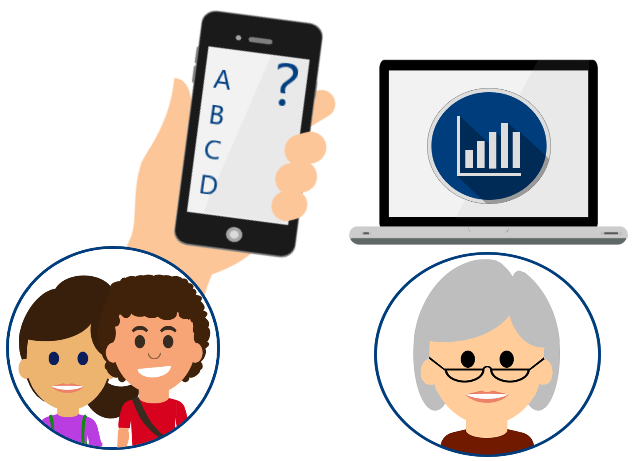 Es gibt einen eigenen Kurs zu der Thematik "ARS", diesen finden Sie
Es gibt einen eigenen Kurs zu der Thematik "ARS", diesen finden Sie